Paul van Yperen's Blog, page 270
June 1, 2018
Madame DuBarry (1919)
Ernst Lubitsch's spectacular costume drama Madame DuBarry (1919) is an operatic version of the life, loves and death of the legendary 18th-century French courtesan. Pola Negri plays DuBarry, who sleeps her way from a worker in a Paris hat shop to to the court of King Louis XV, ultimately becoming his mistress. A cast-of-thousands spectacle, it got both its star and its director noticed by Hollywood.
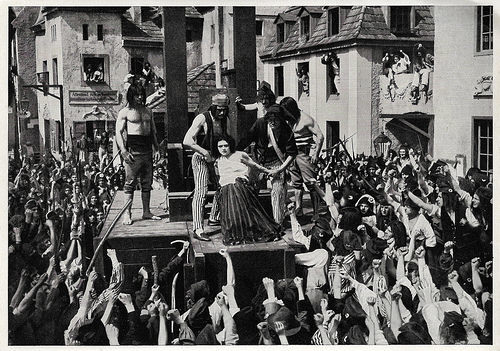
German collectors card by Ross Verlag in the series Vom Werden deutscher Filmkunst - Der Stumme Film, picture no. 67, group 40. Photo: Ufa. Publicity still for Madame Dubarry (Ernst Lubitsch, 1919). Caption: Pola Negri as Madame Dubarry, execution on the market square in Paris.
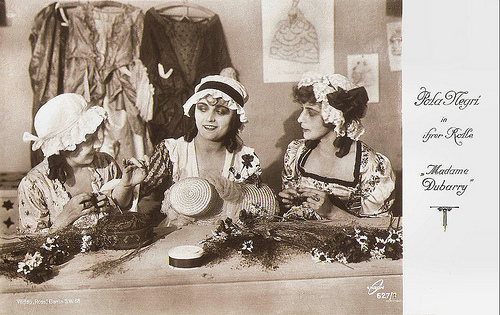
German postcard by Ross Verlag, no. 627/1. Photo: Union. Pola Negri in Madame Dubarry (Ernst Lubitsch, 1918).
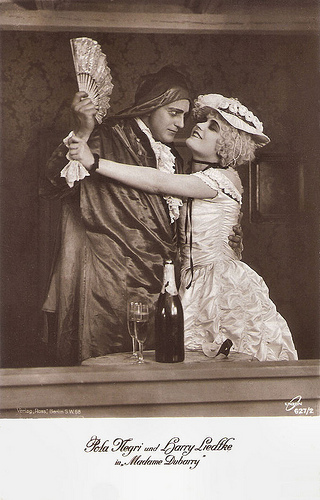
German postcard by Ross Verlag, Berlin, no. 627/2, 1919-1924. Photo: Union. Publicity still for Madame DuBarry (Ernst Lubitsch, 1919) with Pola Negri and Harry Liedtke .
Victim of the Reign of Terror
Ernst Lubitsch 's Madame Dubarry is a historical epic which opened as the premiere attraction of Berlin's impressive Zoopalast theatre on in 1919.
Writers Norbert Falk and Hanns Kraly tell the infamous story of Jeanne Becu, her rise to power's easily-swayed side, and in the end her ultimate fate at the hands of the Reign of Terror.
Pola Negri plays the milliner’s apprentice (in the film named Jeanne Marie Vaubernier), who has come to Paris from the country. Harry Liedtke plays her first love, Armand De Foix.
In a deal to save her next lover, Count DuBarry (Karl Platen), from financial ruin, the Parisian milliner's maid alias Madame DuBarry ( Pola Negri ) becomes the influential mistress of the reigning French king, Louis XV ( Emil Jannings ).
However, this relation is much to the dismay of the Minister of State and Finance, Choiseul ( Reinhard Schünzel ). This brilliant schemer had planned for his sister, the Duchesse de Grammont, to become the Queen of France. Choiseul thus starts a campaign to turn the people against the monarch and his new mistress.
Jeanne soon becomes a symbol for the extravagance of the much-hated aristocracy. When the king dies, Jeanne is ousted by the angry masses and she becomes one of the victims of the Reign of Terror during the French Revolution.
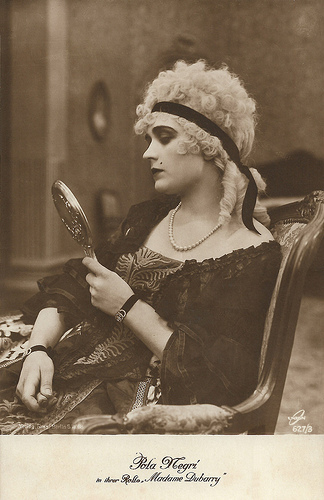
German postcard by Ross Verlag, no. 627/3. Photo: Union. Pola Negri in Madame Dubarry (Ernst Lubitsch, 1918).
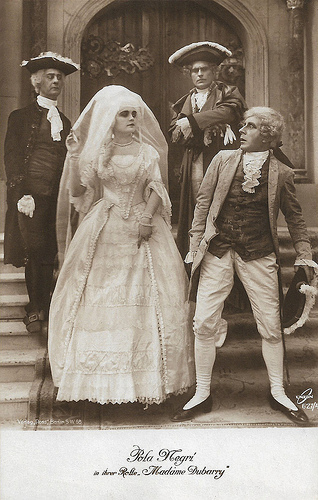
German postcard by Ross Verlag, no. 627/4. Photo: Union Film. Pola Negri in Madame DuBarry (Ernst Lubitsch, 1919). By marrying the aristocrat Guillaume DuBarry (Karl Platen), Jeanne will be accepted at the Royal Court and become Louis XV's mistress. Back right on this card DuBarry's brother Jean (Eduard von Winterstein) who concocted the plan.
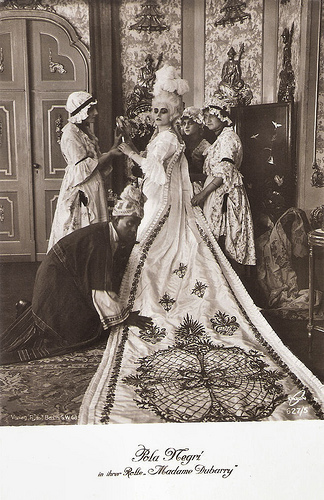
German postcard by Ross Verlag, no. 627/5. Photo: Union Film. Pola Negri in Madame DuBarry (Ernst Lubitsch, 1919).
Far from historical accuracy
Madame DuBarry (1919) had everything: sex, intrigue, war, violence. Shot in part at Frederick the Great’s Sans Souci palace in Potsdam and part in the mammoth film studio of the Ufa formed in 1917, Madame Dubarry displays all the delights of French life at Versailles.
The film was a success in both Europe (except in France) and the U.S., where it was released as Passion, and successfully re-issued in 1928. It was one of the greatest triumphs of Pola Negri .
Negri's flirtatious Madame DuBarry is both comical and sympathetic. Emil Jannings is also excellent as a lecherous, bombastic King Louis XV. Harry Liedtke plays Jeanne's first love, the student Armand de Foix.
Madame DuBarry (1919) was directed by Ernst Lubitsch , written by Norbert Falk and Hanns Kräly. It strays far from historical accuracy, but the narrative is at least coherent.
In reality, King Louis XV died 15 years before the beginning of the French Revolution and Madame DuBarry was long gone from Versailles by the time of the storming of the Bastille. She was 50 when she was executed during the Reign of Terror.
Despite these flaws, Chuck Reilly reviews at IMDb , "the gigantic mob scenes and the final shots of poor Pola being carted off to the guillotine are well-staged and resonate even with modern viewers".
Shari Kizirian at Senses of Cinema : "From the first frame, Pola Negri charms us as Jeanne. Delightfully mischievous, she has a girlish way of getting what she wants. First, seeking someone to tote the hat she is delivering, she catches a stranger’s eye. Cut, and she’s leading him with her parcel in tow toward her true destination, her boyfriend’s place. Next, Sunday lunch with an aristocrat. She chooses the don over her commoner boyfriend, by counting, and then quickly recounting, the ribbons on her dress. Her ultimate prize? A pedicure from a king. When she commands the smitten Louis to sit back down, keeping him from the business of the realm, she exercises exceptional power for a grisette."
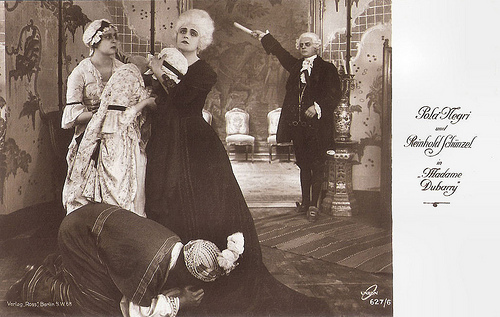
German postcard by Ross Verlag, no. 627/6. Photo: Union Film. Publicity still of Reinhold Schünzel and Pola Negri in Madame DuBarry (Ernst Lubitsch, 1919). After the death of king Louis XV ( Emil Jannings ), his minister Choiseul (Schünzel) chases DuBarry (Negri) from the Royal palace.
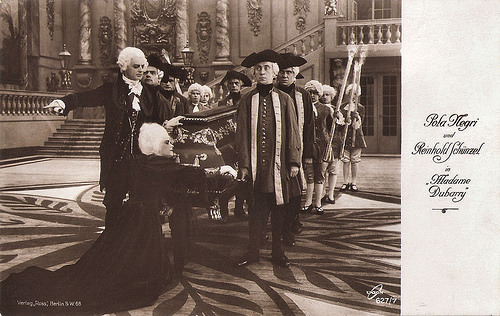
German postcard by Ross Verlag, Berlin, no. 627/7. Photo: Union Film. Publicity still of Reinhold Schünzel and Pola Negri in Madame DuBarry (Ernst Lubitsch, 1919).
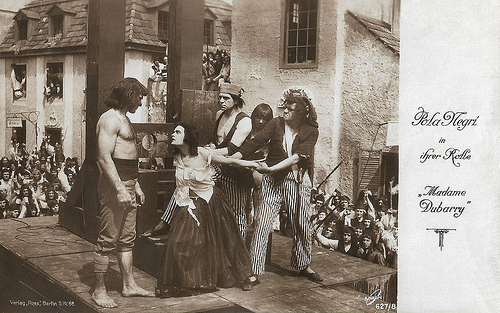
German postcard by Ross Verlag, no. 627/8. Photo: Union. Pola Negri in Madame Dubarry (Ernst Lubitsch, 1918).
Sources: Shari Kizirian (Senses of Cinema), Hal Erickson (AllMovie), Chuck Reilly (IMDb), Filmportal.de, Wikipedia and IMDb.

German collectors card by Ross Verlag in the series Vom Werden deutscher Filmkunst - Der Stumme Film, picture no. 67, group 40. Photo: Ufa. Publicity still for Madame Dubarry (Ernst Lubitsch, 1919). Caption: Pola Negri as Madame Dubarry, execution on the market square in Paris.

German postcard by Ross Verlag, no. 627/1. Photo: Union. Pola Negri in Madame Dubarry (Ernst Lubitsch, 1918).

German postcard by Ross Verlag, Berlin, no. 627/2, 1919-1924. Photo: Union. Publicity still for Madame DuBarry (Ernst Lubitsch, 1919) with Pola Negri and Harry Liedtke .
Victim of the Reign of Terror
Ernst Lubitsch 's Madame Dubarry is a historical epic which opened as the premiere attraction of Berlin's impressive Zoopalast theatre on in 1919.
Writers Norbert Falk and Hanns Kraly tell the infamous story of Jeanne Becu, her rise to power's easily-swayed side, and in the end her ultimate fate at the hands of the Reign of Terror.
Pola Negri plays the milliner’s apprentice (in the film named Jeanne Marie Vaubernier), who has come to Paris from the country. Harry Liedtke plays her first love, Armand De Foix.
In a deal to save her next lover, Count DuBarry (Karl Platen), from financial ruin, the Parisian milliner's maid alias Madame DuBarry ( Pola Negri ) becomes the influential mistress of the reigning French king, Louis XV ( Emil Jannings ).
However, this relation is much to the dismay of the Minister of State and Finance, Choiseul ( Reinhard Schünzel ). This brilliant schemer had planned for his sister, the Duchesse de Grammont, to become the Queen of France. Choiseul thus starts a campaign to turn the people against the monarch and his new mistress.
Jeanne soon becomes a symbol for the extravagance of the much-hated aristocracy. When the king dies, Jeanne is ousted by the angry masses and she becomes one of the victims of the Reign of Terror during the French Revolution.

German postcard by Ross Verlag, no. 627/3. Photo: Union. Pola Negri in Madame Dubarry (Ernst Lubitsch, 1918).

German postcard by Ross Verlag, no. 627/4. Photo: Union Film. Pola Negri in Madame DuBarry (Ernst Lubitsch, 1919). By marrying the aristocrat Guillaume DuBarry (Karl Platen), Jeanne will be accepted at the Royal Court and become Louis XV's mistress. Back right on this card DuBarry's brother Jean (Eduard von Winterstein) who concocted the plan.

German postcard by Ross Verlag, no. 627/5. Photo: Union Film. Pola Negri in Madame DuBarry (Ernst Lubitsch, 1919).
Far from historical accuracy
Madame DuBarry (1919) had everything: sex, intrigue, war, violence. Shot in part at Frederick the Great’s Sans Souci palace in Potsdam and part in the mammoth film studio of the Ufa formed in 1917, Madame Dubarry displays all the delights of French life at Versailles.
The film was a success in both Europe (except in France) and the U.S., where it was released as Passion, and successfully re-issued in 1928. It was one of the greatest triumphs of Pola Negri .
Negri's flirtatious Madame DuBarry is both comical and sympathetic. Emil Jannings is also excellent as a lecherous, bombastic King Louis XV. Harry Liedtke plays Jeanne's first love, the student Armand de Foix.
Madame DuBarry (1919) was directed by Ernst Lubitsch , written by Norbert Falk and Hanns Kräly. It strays far from historical accuracy, but the narrative is at least coherent.
In reality, King Louis XV died 15 years before the beginning of the French Revolution and Madame DuBarry was long gone from Versailles by the time of the storming of the Bastille. She was 50 when she was executed during the Reign of Terror.
Despite these flaws, Chuck Reilly reviews at IMDb , "the gigantic mob scenes and the final shots of poor Pola being carted off to the guillotine are well-staged and resonate even with modern viewers".
Shari Kizirian at Senses of Cinema : "From the first frame, Pola Negri charms us as Jeanne. Delightfully mischievous, she has a girlish way of getting what she wants. First, seeking someone to tote the hat she is delivering, she catches a stranger’s eye. Cut, and she’s leading him with her parcel in tow toward her true destination, her boyfriend’s place. Next, Sunday lunch with an aristocrat. She chooses the don over her commoner boyfriend, by counting, and then quickly recounting, the ribbons on her dress. Her ultimate prize? A pedicure from a king. When she commands the smitten Louis to sit back down, keeping him from the business of the realm, she exercises exceptional power for a grisette."

German postcard by Ross Verlag, no. 627/6. Photo: Union Film. Publicity still of Reinhold Schünzel and Pola Negri in Madame DuBarry (Ernst Lubitsch, 1919). After the death of king Louis XV ( Emil Jannings ), his minister Choiseul (Schünzel) chases DuBarry (Negri) from the Royal palace.

German postcard by Ross Verlag, Berlin, no. 627/7. Photo: Union Film. Publicity still of Reinhold Schünzel and Pola Negri in Madame DuBarry (Ernst Lubitsch, 1919).

German postcard by Ross Verlag, no. 627/8. Photo: Union. Pola Negri in Madame Dubarry (Ernst Lubitsch, 1918).
Sources: Shari Kizirian (Senses of Cinema), Hal Erickson (AllMovie), Chuck Reilly (IMDb), Filmportal.de, Wikipedia and IMDb.
Published on June 01, 2018 22:00
May 31, 2018
Die Puppe (1919)
Ernst Lubitsch's Die Puppe/The Doll (1919) is a romantic fantasy, starring Ossi Oswalda. This charming film is loosely based on the short story by E.T.A. Hoffmann, which also inspired the ballet Coppélia. The great charm of Die Puppe is its mood of fairy-tale unreality.
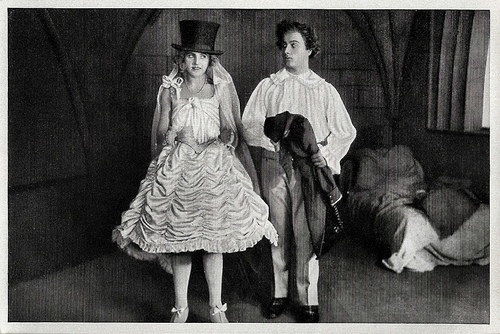
German collectors card by Ross Verlag in the series Vom Werden deutscher Filmkunst - Der Stumme Film, picture no. 117, group 39. Photo: Union. Publicity still for Die Puppe/The Doll (Ernst Lubitsch, 1919). Caption: With Die Puppe/The Doll, Lubitsch created a completely new type of comedy for the screen.
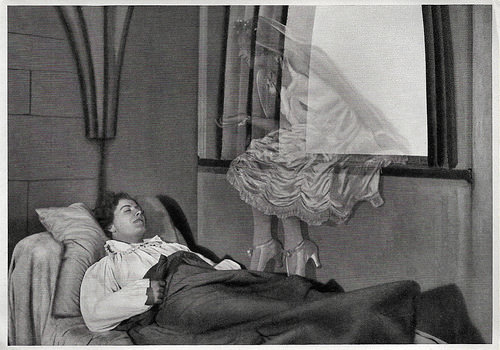
German collectors card by Ross Verlag in the series Vom Werden Deutscher Filmkunst - Der Stumme Film, no. 164, Group 40. Photo: Ufa. Publicity still for Die Puppe/The Doll (Ernst Lubitsch, 1919). Caption: From the film Die Puppe. Trick shot. Ossi Oswalda appears in Hermann Thimig 's dream.
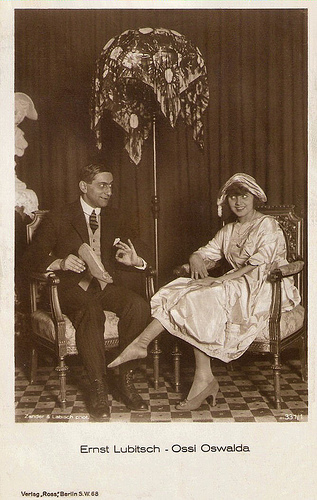
Ernst Lubitsch and Ossi Oswalda . German postcard by Ross Verlag, Berlin, no. 337/1, 1919-1924. Photo: Zander & Labisch.
A special service for bachelors, widowers and misogynists
In the opening shot of Die Puppe/The Doll, Ernst Lubitsch sets up a doll's house against a stylised backdrop. A close-up of this model then dissolves into a full-sized version of the same stylised setting, from which emerge actors dressed as dolls. From this point onward, the entire film is staged on highly stylised sets.
The old Baron von Chanterelle (Max Kronert) has no family except for his gormless nephew Lancelot ( Hermann Thimig ). He wants to preserve his family line, so he forces Lancelot to choose one of the village maidens to wed.
Lancelot flees to a monastery to escape the forty eager maidens. The Baron offers his nephew a dowry of 300,000 francs to get married. But Lancelot is afraid of women.
The prior (Jacob Tiedtke) shows him an advertisement from the doll-maker Hilarius (Victor Janson), who offers a special service 'for bachelors, widowers and misogynists': a life-size clockwork girl! Lancelot decides to marry the mechanical bride, collect the dowry, then stash the doll in the attic.
Hilarius has just finished making a replica of his pretty daughter Ossi ( Ossi Oswalda ). The clockwork girl has a control panel on her back and a crank to wind her up.
The doll-maker's young apprentice (Gerhard Ritterband) accidentally breaks the arm of the doll and convinces the real Ossi to mimic the doll. Lancelot buys her, thinking she is a doll, and takes her back to the monastery, where they are wed.
Ernst Lubitsch once wrote to his biographer Herman G. Weinberg that he considered Die Puppe and Die Austernprinzessin/The Oyster Princess (1919) as his most outstanding comedies produced in Germany before he departed for Hollywood to make Rosita (1923).
The great charm of Die Puppe is its mood of fairy-tale unreality. The coachman's horses are played by men in pantomime-horse costumes. A cat and a rooster are played by cut-out figures. The moon has a human face.
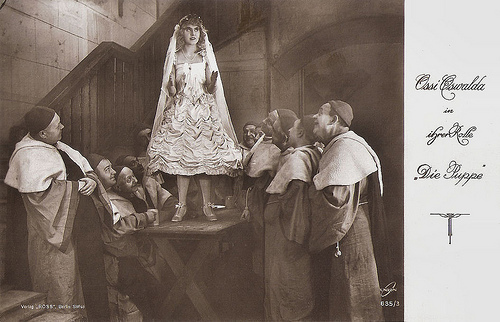
German postcard by Ross Verlag, Berlin, no. 635/3 1919-1924. Photo: Union. Publicity still for Die Puppe/The Doll (Ernst Lubitsch, 1919) with Ossi Oswalda
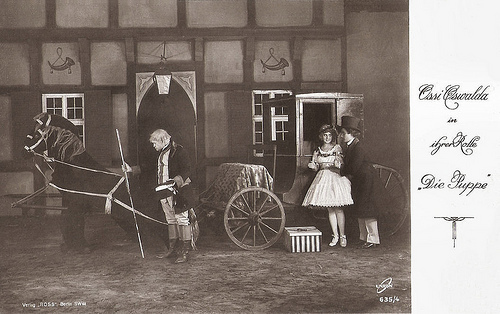
German postcard by Ross Verlag, Berlin, no. 635/4 1919-1924. Photo: Union. Publicity still for Die Puppe/The Doll (Ernst Lubitsch, 1919) with Ossi Oswalda and Hermann Thimig .
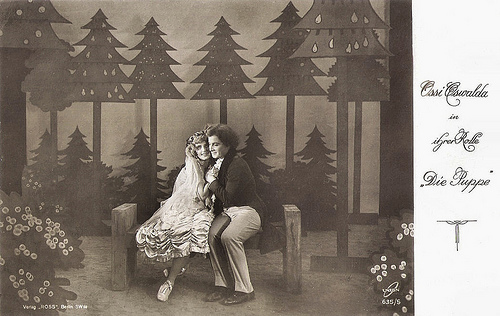
German postcard by Ross Verlag, Berlin, no. 635/5 1919-1924. Photo: Union. Publicity still for Die Puppe/The Doll (Ernst Lubitsch, 1919) with Ossi Oswalda and Hermann Thimig .
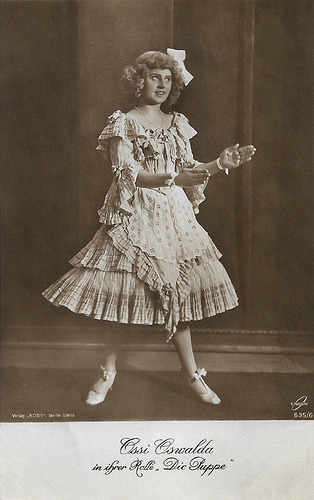
German postcard by Ross Verlag, Berlin, no. 635/6. Photo: Union. Ossi Oswalda in Die Puppe/The Doll (Ernst Lubitsch, 1919).
Sources: Will Gilbert (IMDb), Wikipedia and IMDb.

German collectors card by Ross Verlag in the series Vom Werden deutscher Filmkunst - Der Stumme Film, picture no. 117, group 39. Photo: Union. Publicity still for Die Puppe/The Doll (Ernst Lubitsch, 1919). Caption: With Die Puppe/The Doll, Lubitsch created a completely new type of comedy for the screen.

German collectors card by Ross Verlag in the series Vom Werden Deutscher Filmkunst - Der Stumme Film, no. 164, Group 40. Photo: Ufa. Publicity still for Die Puppe/The Doll (Ernst Lubitsch, 1919). Caption: From the film Die Puppe. Trick shot. Ossi Oswalda appears in Hermann Thimig 's dream.

Ernst Lubitsch and Ossi Oswalda . German postcard by Ross Verlag, Berlin, no. 337/1, 1919-1924. Photo: Zander & Labisch.
A special service for bachelors, widowers and misogynists
In the opening shot of Die Puppe/The Doll, Ernst Lubitsch sets up a doll's house against a stylised backdrop. A close-up of this model then dissolves into a full-sized version of the same stylised setting, from which emerge actors dressed as dolls. From this point onward, the entire film is staged on highly stylised sets.
The old Baron von Chanterelle (Max Kronert) has no family except for his gormless nephew Lancelot ( Hermann Thimig ). He wants to preserve his family line, so he forces Lancelot to choose one of the village maidens to wed.
Lancelot flees to a monastery to escape the forty eager maidens. The Baron offers his nephew a dowry of 300,000 francs to get married. But Lancelot is afraid of women.
The prior (Jacob Tiedtke) shows him an advertisement from the doll-maker Hilarius (Victor Janson), who offers a special service 'for bachelors, widowers and misogynists': a life-size clockwork girl! Lancelot decides to marry the mechanical bride, collect the dowry, then stash the doll in the attic.
Hilarius has just finished making a replica of his pretty daughter Ossi ( Ossi Oswalda ). The clockwork girl has a control panel on her back and a crank to wind her up.
The doll-maker's young apprentice (Gerhard Ritterband) accidentally breaks the arm of the doll and convinces the real Ossi to mimic the doll. Lancelot buys her, thinking she is a doll, and takes her back to the monastery, where they are wed.
Ernst Lubitsch once wrote to his biographer Herman G. Weinberg that he considered Die Puppe and Die Austernprinzessin/The Oyster Princess (1919) as his most outstanding comedies produced in Germany before he departed for Hollywood to make Rosita (1923).
The great charm of Die Puppe is its mood of fairy-tale unreality. The coachman's horses are played by men in pantomime-horse costumes. A cat and a rooster are played by cut-out figures. The moon has a human face.

German postcard by Ross Verlag, Berlin, no. 635/3 1919-1924. Photo: Union. Publicity still for Die Puppe/The Doll (Ernst Lubitsch, 1919) with Ossi Oswalda

German postcard by Ross Verlag, Berlin, no. 635/4 1919-1924. Photo: Union. Publicity still for Die Puppe/The Doll (Ernst Lubitsch, 1919) with Ossi Oswalda and Hermann Thimig .

German postcard by Ross Verlag, Berlin, no. 635/5 1919-1924. Photo: Union. Publicity still for Die Puppe/The Doll (Ernst Lubitsch, 1919) with Ossi Oswalda and Hermann Thimig .

German postcard by Ross Verlag, Berlin, no. 635/6. Photo: Union. Ossi Oswalda in Die Puppe/The Doll (Ernst Lubitsch, 1919).
Sources: Will Gilbert (IMDb), Wikipedia and IMDb.
Published on May 31, 2018 22:00
May 30, 2018
Carmen (1918)
In Lubitsch's silent drama Carmen (Ernst Lubitsch, 1918) the gypsy vamp was of course played by Pola Negri. She does a great job. Her Don José was played by Harry Liedtke. The film was an international success.
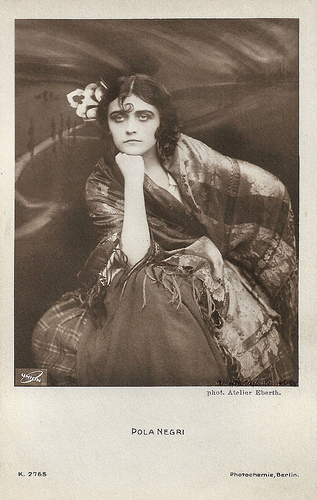
German postcard by Photochemie, Berlin, no. K. 2765. Photo: Atelier Eberth / Union. Pola Negri as Carmen in the German silent drama Carmen (Ernst Lubitsch, 1918).
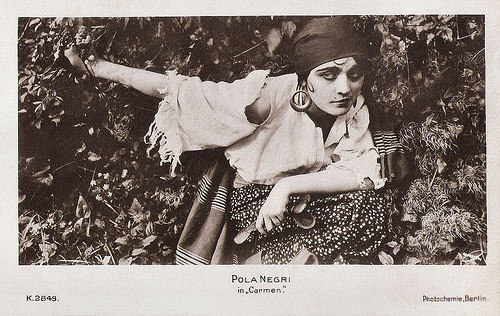
German postcard by Photochemie, Berlin, no. K. 2849. Photo: Union. Pola Negri as Carmen in Carmen (Ernst Lubitsch, 1918).
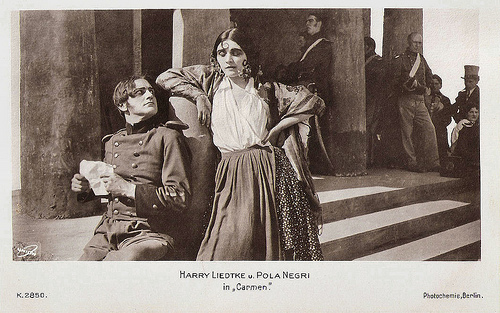
German postcard by Photochemie, Berlin, no. K. 2850. Photo: Union. Pola Negri as Carmen and Harry Liedtke as Don José in the German silent drama Carmen (Ernst Lubitsch, 1918).
Sassy, playful, capricious, cruel, generous…
Ernst Lubitsch ’s career as a filmmaker blossomed just as the First World War was drawing to a close. In 1918, he went from being mostly a comedic director to a supposedly more serious filmmaker of pseudo-historical tragedies, with bigger budgets and a new star - Pola Negri , a fellow actor from the Deutsches Theater.
Lubitsch based his drama Carmen (1918) on the novella Carmen by Prosper Mérimée. Like George Bizet's opera Carmen, the film only adapts the third part of Mérimée's novella.
Lubitsch transformed the character of Don José ( Harry Liedtke ) at the beginning of the story from bandit on the run to honest man in love with his childhood sweetheart.
The story is told by a man at a camp-fire who says that it took place many years before. Don José was a Dragoon Sergeant in Sevilla who fell madly in love with Carmen ( Pola Negri ), a beautiful gypsy. For her, he killed an officer and gave up his fiancée and his career in the army, and became a smuggler.
But Carmen's love did not last. She left him and went to Gibraltar where she fell in love with the famous bullfighter Escamillo. Back in Sevilla, Carmen rode triumphantly in Escamillo's carriage on his way to a bullfight. At the end of the bullfight, José confronted Carmen and when she told him that she no longer loved him, stabbed her to death.
Back at the camp-fire seen at the beginning, the man who told the story adds that some say that Carmen did not die ′for she was in league with the Devil himself.'
Carmen debuted in December 1918 at the U.T. Lichtspiele on Kurfürstendamm. It was a huge success in Germany with audiences and press.
After the unexpected American success of Madame Dubarry (released as Passion in December 1919), Carmen was re-edited for an American release in 1921, as Gypsy Blood. In the American version the framing story was hand-coloured and Lubitsch’s name was left off the credits. Adolph Zukor brought Pola Negri to Hollywood in the summer of 1922. He was not interested in Lubitsch, who had also hoped to get a contract with Paramount.
In her review at Movies Silently, Fritzi Kramer writes: "I am a fan of Geraldine Farrar ’s lively take on the role in the 1915 Cecil B. DeMille version but Pola Negri is the best silent Carmen by far. Sassy, playful, capricious, cruel, generous… Negri projects all of Carmen’s contradictions on the screen and delivers an astonishing performance."
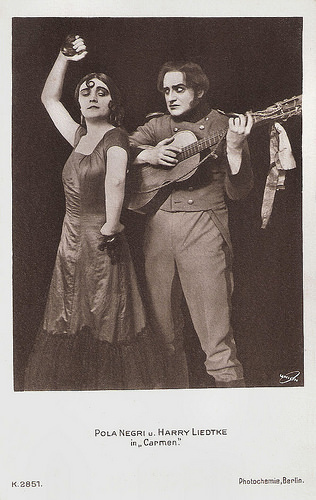
German postcard by Photochemie, Berlin, no. K. 2851. Photo: Union. Pola Negri as Carmen and Harry Liedtke as Don José in Carmen (Ernst Lubitsch, 1918).
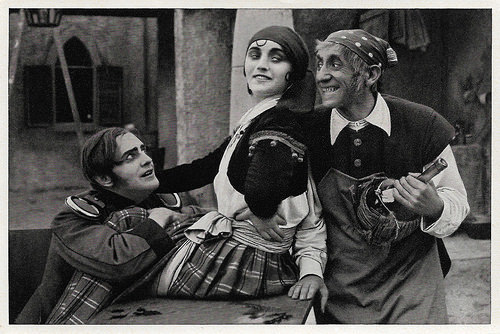
German collectors card by Ross Verlag in the series Vom Werden deutscher Filmkunst - Der Stumme Film, picture no, 59, group 43. Photo: Ufa. Publicity still for Carmen (Ernst Lubitsch, 1918) with Harry Liedtke and Pola Negri .
Sources: Fritzi Kramer (Movies Silently), Stefan Droessler (Le Gionate del Cinema Muto), Wikipedia and IMDb.

German postcard by Photochemie, Berlin, no. K. 2765. Photo: Atelier Eberth / Union. Pola Negri as Carmen in the German silent drama Carmen (Ernst Lubitsch, 1918).

German postcard by Photochemie, Berlin, no. K. 2849. Photo: Union. Pola Negri as Carmen in Carmen (Ernst Lubitsch, 1918).

German postcard by Photochemie, Berlin, no. K. 2850. Photo: Union. Pola Negri as Carmen and Harry Liedtke as Don José in the German silent drama Carmen (Ernst Lubitsch, 1918).
Sassy, playful, capricious, cruel, generous…
Ernst Lubitsch ’s career as a filmmaker blossomed just as the First World War was drawing to a close. In 1918, he went from being mostly a comedic director to a supposedly more serious filmmaker of pseudo-historical tragedies, with bigger budgets and a new star - Pola Negri , a fellow actor from the Deutsches Theater.
Lubitsch based his drama Carmen (1918) on the novella Carmen by Prosper Mérimée. Like George Bizet's opera Carmen, the film only adapts the third part of Mérimée's novella.
Lubitsch transformed the character of Don José ( Harry Liedtke ) at the beginning of the story from bandit on the run to honest man in love with his childhood sweetheart.
The story is told by a man at a camp-fire who says that it took place many years before. Don José was a Dragoon Sergeant in Sevilla who fell madly in love with Carmen ( Pola Negri ), a beautiful gypsy. For her, he killed an officer and gave up his fiancée and his career in the army, and became a smuggler.
But Carmen's love did not last. She left him and went to Gibraltar where she fell in love with the famous bullfighter Escamillo. Back in Sevilla, Carmen rode triumphantly in Escamillo's carriage on his way to a bullfight. At the end of the bullfight, José confronted Carmen and when she told him that she no longer loved him, stabbed her to death.
Back at the camp-fire seen at the beginning, the man who told the story adds that some say that Carmen did not die ′for she was in league with the Devil himself.'
Carmen debuted in December 1918 at the U.T. Lichtspiele on Kurfürstendamm. It was a huge success in Germany with audiences and press.
After the unexpected American success of Madame Dubarry (released as Passion in December 1919), Carmen was re-edited for an American release in 1921, as Gypsy Blood. In the American version the framing story was hand-coloured and Lubitsch’s name was left off the credits. Adolph Zukor brought Pola Negri to Hollywood in the summer of 1922. He was not interested in Lubitsch, who had also hoped to get a contract with Paramount.
In her review at Movies Silently, Fritzi Kramer writes: "I am a fan of Geraldine Farrar ’s lively take on the role in the 1915 Cecil B. DeMille version but Pola Negri is the best silent Carmen by far. Sassy, playful, capricious, cruel, generous… Negri projects all of Carmen’s contradictions on the screen and delivers an astonishing performance."

German postcard by Photochemie, Berlin, no. K. 2851. Photo: Union. Pola Negri as Carmen and Harry Liedtke as Don José in Carmen (Ernst Lubitsch, 1918).

German collectors card by Ross Verlag in the series Vom Werden deutscher Filmkunst - Der Stumme Film, picture no, 59, group 43. Photo: Ufa. Publicity still for Carmen (Ernst Lubitsch, 1918) with Harry Liedtke and Pola Negri .
Sources: Fritzi Kramer (Movies Silently), Stefan Droessler (Le Gionate del Cinema Muto), Wikipedia and IMDb.
Published on May 30, 2018 22:00
May 29, 2018
Ernst Lubitsch
The next ten days, EFSP has its own little Lubitsch festival! We will do posts on 9 of his films, but we start today with a post on the master himself, Ernst Lubitsch (1892-1947). The German-American actor, screenwriter, producer and film director started his career in the silent cinema of the Weimar Republic. During the 1920s, his urbane comedies of manners made him Hollywood's most elegant and sophisticated director. His films were promoted as having 'the Lubitsch touch', due to his wit and style.

German postcar by Ross Verlag, no. 415/1, 1919-1924. Photo: Rembrandt.
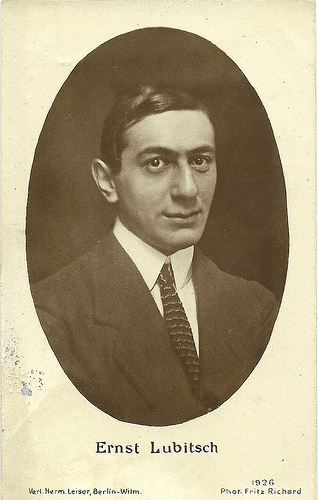
German postcard by Verlag Hermann Leiser, Berlin-Wilm., no. 1926. Photo: Fritz Richard. Collection: Didier Hanson.
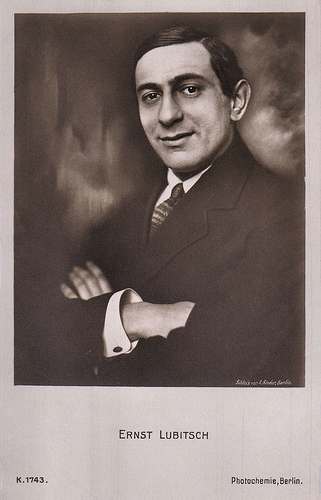
German postcard by Photochemie, no. K. 1743. Photo: Alex Binder, Paris. Collection: Marlene Pilaete.
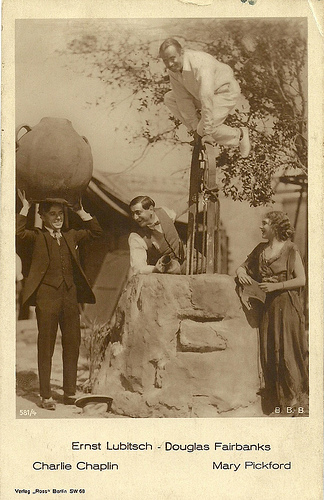
German postcard by Ross Verlag, Berlin, no. 581/4, 1919-1924. Photo: B.B.B. Collection: Didier Hanson. Ernst Lubitsch with Douglas Fairbanks , Charlie Chaplin and Mary Pickford.
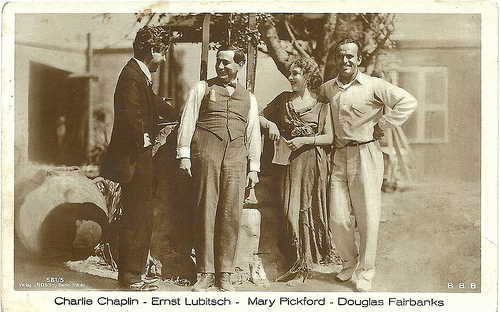
German postcard by Ross Verlag, no. 581/5, 1919-1924. Photo: B.B.B. Collection: Didier Hanson. Ernst Lubitsch with Charlie Chaplin , Mary Pickford and Douglas Fairbanks .
Ethnic Jewish Humour
Ernst Lubitsch was born in Berlin, Germany, in 1892. He was the son of Anna (née Lindenstaedt) and Simon Lubitsch, a prosperous tailor. His family was Ashkenazi Jewish, his father born in Grodno and his mother from Wriezen (Oder), outside Berlin.
Ernst was drawn to the stage while participating in plays staged by the Sophien Gymnasium, his Berlin high school, which he quit at 16.
To satisfy both his own urge to act and his father's desire that he take over the family business, he began leading a double life, working as a bookkeeper at his father's store by day and appearing in cabarets and music halls by night.
By 1911, he was a member of Max Reinhardt's renowned Deutsches Theater, where he quickly advanced from bit parts to character leads. To supplement his income, Lubitsch took a job in 1912 as an apprentice and general-purpose handyman at Berlin's Bioscope film studios, and learned silent film acting.
Lubitsch soon made his film debut in Die ideale Gattin/The Ideal Wife (Hanns Heinz Ewers, Marc Henry, 1913) with Lyda Salmanova . The comedy Die Firma heiratetThe Firm Weds (Carl Wilhelm, 1913) with Albert Paulig , and its sequel Der Stolz der Firma/The Pride of the Firm (Carl Wilhelm, 1914) turned him into a popular comedian.
Till 1920, he acted in approximately thirty films. Lubitsch appeared in a series of very successful film comedies as a character named Meyer in which he emphasised ethnic Jewish humour, including Meyer auf der Alm (?, 1913), and Meyer Als Soldat/Meyer as Soldier (?, 1914).
In 1914 he began to write and direct his own films. His first film as a director in was Fräulein Seifenschaum/Miss Soapsuds(1914) and he established his reputation as a director, writer, producer and comedian with the foundation of the Malu-Film company, together with the actor Ernst Matráy .
He made his mark as a serious director with the drama Die Augen der Mumie Ma/The Eyes of the Mummy (Ernst Lubitsch, 1918), starring Pola Negri . He gradually abandoned acting to concentrate on directing and his last film appearance was opposite Pola Negri and Paul Wegener in the drama Sumurun (Ernst Lubitsch, 1920).

With Ossi Oswalda . German postcard by Ross Verlag, Berlin, no. 337/1, 1919-1924. Photo: Zander & Labisch.
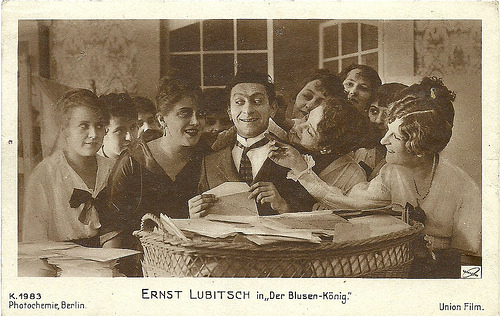
German postcard by Photochemie, no. K. 1983. Photo: Union Film. Publicity still for Der Blusen-König (Ernst Lubitsch, 1917). Collection: Didier Hanson.
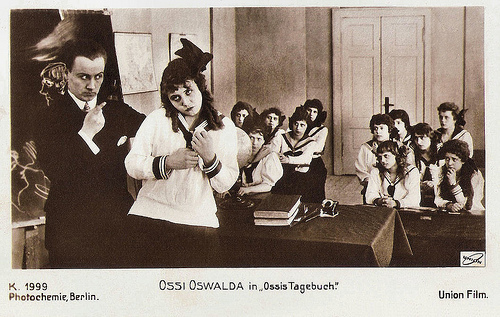
German postcard by Photochemie, Berlin, no. K. 1999. Photo: Union Film. Ossi Oswalda and Hermann Thimig in the Ossi's Tagebuch (Ernst Lubitsch, 1917).
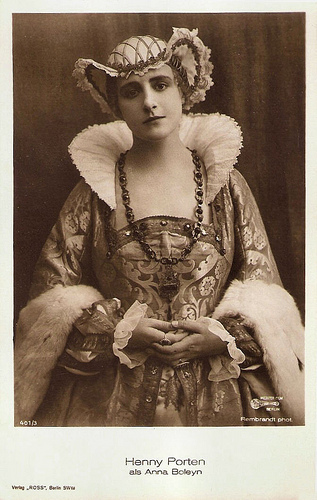
Henny Porten as Anna Boleyn, in Anna Boleyn (1920). German postcard by Ross Verlag, Berlin, no. 645/3, 1919-1924. Photo: Union Film.
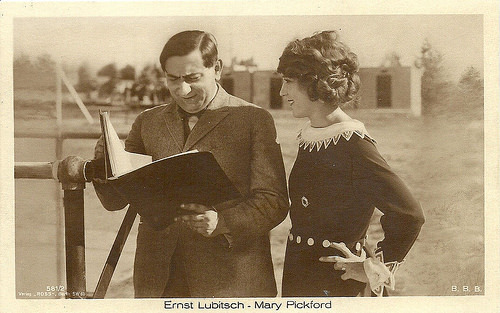
German postcard by Ross Verlag, no. 581/2, 1919-1924. Photo: B.B.B. Collection: Didier Hanson. Ernst Lubitsch with Mary Pickford.
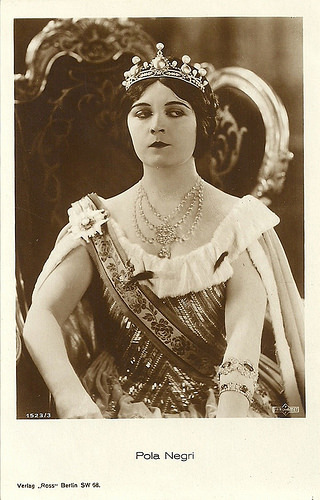
German postcard by Ross Verlag, no. 1523/3, 1927-1928. Photo: Parufamet. Pola Negri in Forbidden Paradise (Ernst Lubitsch, 1924).
Grand Master
As a director, Ernst Lubitsch alternated between escapist comedies and large-scale historical dramas, enjoying great international success with both.
A triumph was Die Austernprinzessin/The Oyster Princess (Ernst Lubitsch, 1919), featuring Ossi Oswalda , a sparkling satire caricaturing American manners.
Ephraim Katz in The Film Encyclopedia : "For the first time he demonstrated the subtle humor and the virtuoso visual wit that would in time become known as 'the Lubitsch Touch'. The style was characterised by a parsimonious compression of ideas and situations into single shots or brief scenes that provided an ironic key to the characters and to the meaning of the entire film."
His reputation as a grand master of world cinema reached a new peak after the release of his spectacles Madame DuBarry/Passion (Ernst Lubitsch, 1919) with Pola Negri , and Anna Boleyn/Deception (Ernst Lubitsch, 1920) starring Henny Porten and Emil Jannings . Both of these films found American distributorship by early 1921.
Madame Du Barry and Anna Boleyn, along with his Carmen/Gypsy Blood (Ernst Lubitsch, 1921) were selected by The New York Times on its list of the 15 most important movies of 1921.
With glowing reviews under his belt, and American money flowing his way, Lubitsch formed his own production company and made the high-budget spectacular Das Weib des Pharao/The Loves of Pharaoh (Ernst Lubitsch, 1921).
In 1922, he married Helene Kraus. They divorced in 1931.
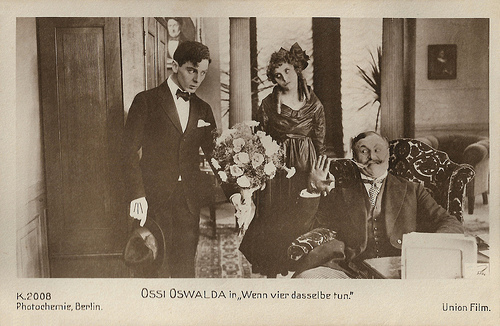
German postcard by Photochemie, Berlin, no. K. 2008. Photo: Union-Film. Publicity still for Wenn vier dasselbe tun/When Four Do the Same (Ernst Lubitsch, 1917), starring Ossi Oswalda as the girl, Fritz Schulz (here on the left) as her lover, and Emil Jannings as her father (here on the right).
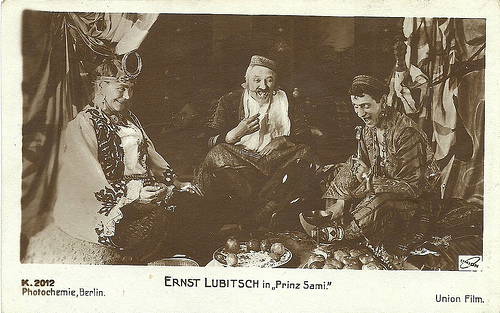
German postcard by Photochemie, Berlin, no. K. 2012. Photo: Union Film. Publicity still for Prinz Sami/Prince Sami (Ernst Lubitsch, 1918). Collection: Didier Hanson.
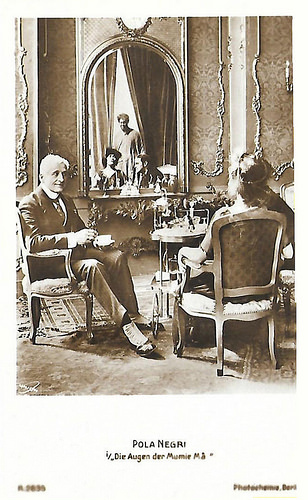
German postcard by Photochemie, Berlin, no. K. 2835. Photo: publicity still for Die Augen der Mumie Ma/The Eyes of the Mummy (Ernst Lubitsch, 1918) with Pola Negri . Collection: Didier Hanson.
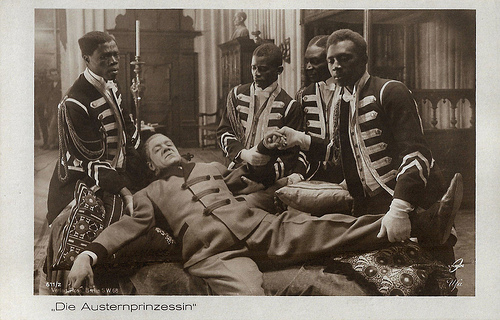
German postcard by Ross Verlag, Berlin, no. 611/2. Photo: Union / Ufa. Publicity still for Die Austernprinzessin/The Oyster Princess (Ernst Lubitsch, 1919) with Victor Janson.

German postcard by Ross Verlag, no. 627/6. Photo: Union Film. Publicity still of Reinhold Schünzel and Pola Negri in Madame DuBarry (Ernst Lubitsch, 1919). After the death of king Louis XV ( Emil Jannings ), his minister Choiseul (Schünzel) chases DuBarry (Negri) from the Royal palace.
Hollywood
Ernst Lubitsch's success in Europe brought him to the shores of America to promote Das Weib des Pharao/The Loves of Pharaoh (1922) and he got acquainted with the thriving US film industry.
Lubitsch returned briefly to Germany but soon left for good for Hollywood. He was contracted by Mary Pickford, who wanted him to direct her in Dorothy Vernon of Haddon Hall. Upon arrival, he rejected the project and directed her instead in Rosita (1923).
Director and star clashed during its filming. While the resuly was deemed a failure from her point of view, it was a critical and commercial success. It ended up as the only project that they made together.
A free agent after just one American film, Lubitsch was signed to a remarkable three-year, six-picture contract by Warner Brothers that guaranteed the director his choice of both cast and crew, and full editing control over the final cut.
Settling in America, Lubitsch established his reputation for sophisticated comedy with such stylish films as The Marriage Circle (1924), Lady Windermere's Fan (1925), and So This Is Paris (1926).
Ephraim Katz: "Lubitsch grasped the American psychology with an amazing accuracy and focused his satire on two main themes -- sex and money. With characteristic laconic wit, he depicted sex as a frivolous pastime, a sophisticated game moneyed people play to occupy their hours of leisure. To be safe, he set his plots against foreign backgrounds -- Paris, Vienna, Budapest -- or some mythical land, but the implication was clearly American and audiences rarely failed to recognize themselves or their friends, their manners, their foibles, their weaknesses."
But his films were only marginally profitable for Warner Brothers, and Lubitsch's contract was eventually dissolved by mutual consent, with MGM-Paramount buying out the remainder.
His first film for MGM, The Student Prince in Old Heidelberg (1927) with Ramon Novarro , was well regarded, but also lost money.

German postcard by Ross Verlag, Berlin, no. 635/5, 1919-1924. Photo: Union. Publicity still for Die Puppe/The Doll (Ernst Lubitsch, 1919) with Ossi Oswalda and Hermann Thimig .
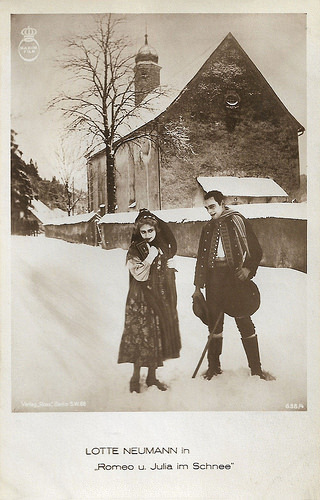
German postcard by Ross Verlag, no. 636/4. Photo: Maxim Film. Publicity still for Romeo und Julia im Schnee/Romeo and Juliet in the Snow (Ernst Lubitsch, 1920), with Lotte Neumann (Julia) and Gustav von Wangenheim (Romeo Montekugerl).
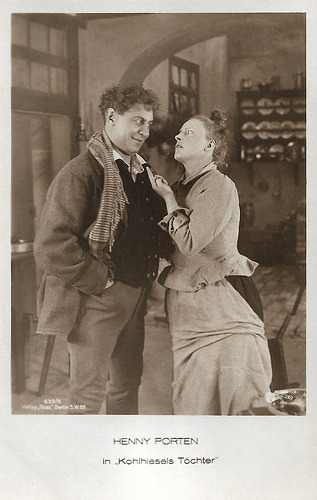
German postcard by Ross Verlag no. 639/5. Photo: Messter-Film. Publicity still for Kohlhiesels Töchter/Kohlhiesel's Daughters (Ernst Lubitsch, 1920) with Emil Jannings and Henny Porten .
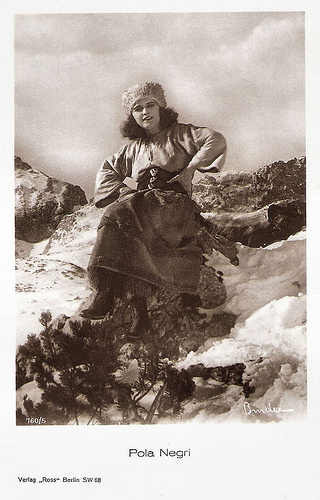
German postcard by Ross Verlag, Berlin, no. 760/5. Photo: Alex Binder. Publicity still for Die Bergkatze/Wildcat (Ernst Lubitsch, 1921) with Pola Negri .
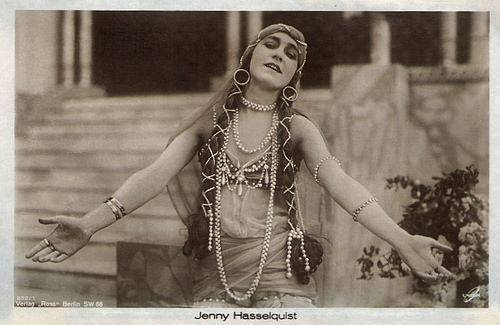
German postcard by Ross Verlag, Berlin, no. 832/1, 1919-1924. Union Film. Publicity still for Sumurun (Ernst Lubitsch, 1920) with Jenny Hasselqvist aka Jenny Hasselquist.
Musicals
Lubitsch seized upon the advent of talkies to direct musicals. With his first sound film, The Love Parade (1929), starring Maurice Chevalier and Jeanette MacDonald, Lubitsch hit his stride as a maker of worldly musical comedies and earned himself another Oscar nomination.
While most of Lubitsch's silent films had been made for Warner Bros., most of his early sound pictures were for Paramount.
The Love Parade (1929), Monte Carlo (1930), and The Smiling Lieutenant (1931) were hailed by critics as masterpieces of the newly emerging musical genre. Lubitsch served on the faculty of the University of Southern California for a time.
His next film was a romantic comedy, written with Samson Raphaelson, Trouble in Paradise (1932). The cynical comedy was popular both with critics and with audiences.
But it was a project that could only have been made before the enforcement of the Production Code, and after 1935, Trouble in Paradise was withdrawn from circulation. It was not seen again until 1968.
Ernst Lubitsch continued to specialize in comedy, whether with music, as in MGM's opulent The Merry Widow (1934) and Paramount's One Hour with You (1932), or without, as in Design for Living (1933).
He made only one other dramatic film, the anti-war Broken Lullaby/The Man I Killed (1932).
In 1935, he was appointed Paramount's production manager, thus becoming the only major Hollywood director to run a large studio.
But Lubitsch had trouble delegating authority, which was a problem when he was overseeing sixty different films. He was fired after a year on the job, and returned to full-time moviemaking.
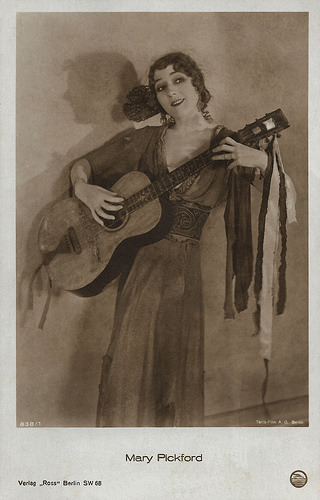
German postcard by Ross Verlag, no. 838/1. Photo: Terra Film A.G., Berlin. Publicity still for Rosita (Ernst Lubitsch, 1923).
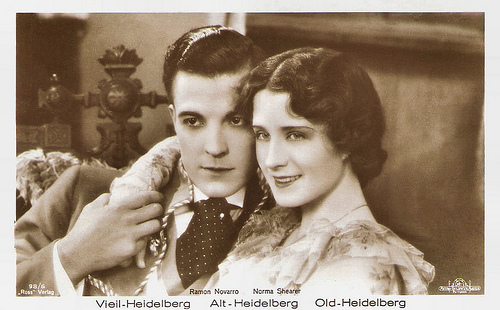
Ramon Novarro and Norma Shearer. German postcard by Ross Verlag, no. 98/6. Photo: Metro-Goldwyn-Mayer. Publicity still for The Student Prince in Old Heidelberg (Ernst Lubitsch, 1927).
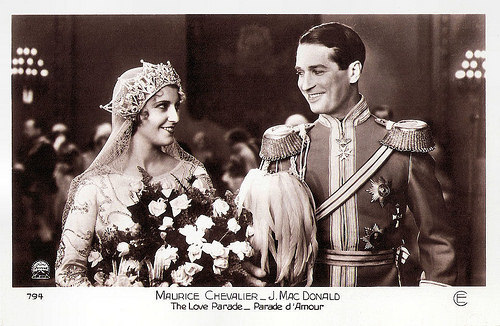
French postcard by Cinémagazine Edition, Paris, no. 794. Photo: Paramount. Publicity still for The Love Parade (Ernst Lubitsch, 1929) with Maurice Chevalier and Jeanette MacDonald.
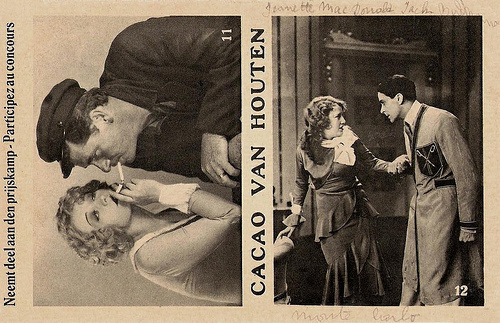
Dutch-Belgian promotion card for Cacao Van Houten, no. 11 and 12. Printed by N.V. Ned Reclamefabriek. This card was part of a series of promo cards for a quiz by Van Houten Chocolate. The public had to go to stores to guess which film star was on the photo in the shop window. There were 24 photos. At the right we recognized (with the help from a former owner of the card :)) Jack Buchanan and Jeanette MacDonald in Monte Carlo (Ernst Lubitsch, 1930). But who are the actors on the other picture? Name also the title of the film and the production company. In the past you could win a Philips Radio...
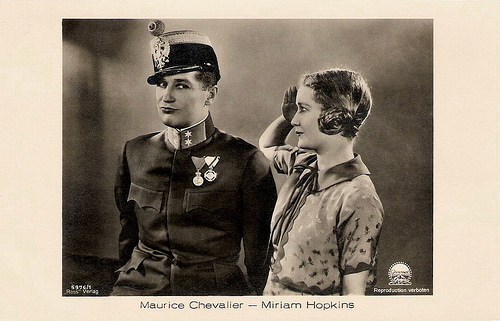
Maurice Chevalier and Miriam Hopkins. German postcard by Ross Verlag, no. 5976/1, 1931-1932. Photo: Paramount. Publicity still for The Smiling Lieutenant (Ernst Lubitsch, 1931).
Garbo Laughs!
In 1935 he married his second wife, British actress Vivian Gaye. They had one daughter, Nicola Lubitsch in 1938. And in 1936, he became a naturalized US citizen.
Lubitsch moved to MGM, and directed Greta Garbo in Ninotchka (1939). The famously serious actress' laughing scene in this satirical comedy was heavily promoted by studio publicists with the tagline "Garbo Laughs!"
In 1940, Lubitsch directed The Shop Around the Corner, an artful comedy of cross purposes.
The film reunited Lubitsch with his Merry Widow screenwriter Raphaelson, and starred James Stewart and Margaret Sullavan as a pair of bickering co-workers in Budapest, each unaware that the other is their secret romantic correspondent.
Lubitsch went independent to direct That Uncertain Feeling (1941, a remake of his 1925 film Kiss Me Again), and the dark anti-Nazi farce To Be or Not to Be (1942).
William McPeak at IMDb on To Be or Not to Be (1942): "a biting satire of Nazi tyranny that also poked fun at Lubitsch's own theater roots with the problems and bickering--but also the triumph--of a somewhat raggedy acting troupe in Warsaw during the Nazi occupation. Jack Benny's perfect deadpan humor worked well with the zany vivaciousness of Carole Lombard, and a cast of veteran character actors from both Hollywood and Lubitsch's native Germany provided all the chemistry needed to make this a classic comedy, as well as a fierce statement against the perpetrators of war."
A heart condition curtailed his activity, and he spent much of his time in supervisory capacities. His next film, Heaven Can Wait (1943) was another Raphaelson collaboration.
Then, Lubitsch worked with Edwin Justus Mayer on the scripting process of A Royal Scandal (1945), a remake of Lubitsch's silent film A Forbidden Paradise. The script was written and prepared under Lubitsch, and he was the original director of this film, and directed the rehearsals. He became ill during shooting, so he hired Otto Preminger, another disciple of Max Reinhardt's Viennese theatre work, to do the rest of the shooting.
After A Royal Scandal, Lubitsch regained his health, and directed Cluny Brown (1946), with Charles Boyer and Jennifer Jones.
In 1947, he was awarded a Special Academy Award. Ernst Lubitsch died later that year in Hollywood of a heart attack, his sixth. He was 55.
His last film, That Lady in Ermine (1948) with Betty Grable, was completed by Otto Preminger and released posthumously.

German postcard by Ross Verlag, no. 6732/1, 1931-1932. Photo: Paramount. Publicity still for One Hour with You (Ernst Lubitsch, 1932) with Roland Young, Genevieve Tobin, Jeanette MacDonald, and Maurice Chevalier .
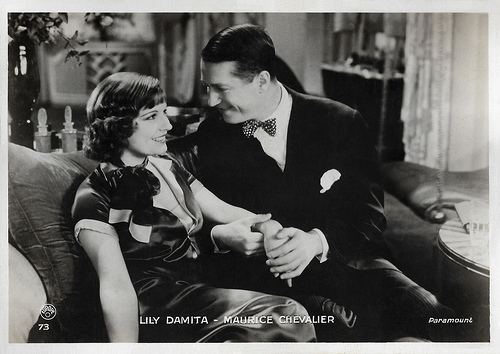
French postcard by Europe, no. 73. Photo: Paramount. Maurice Chevalier and Lily Damita in Une heure près de toi (George Cukor, Ernst Lubitsch, 1932), the French language version of One Hour With You.
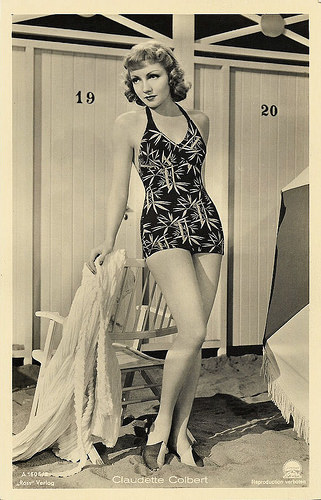
German postcard by Ross Verlag, no. 1606/2, 1937-1938. Photo: Paramount. Publicity still for Bluebeard's Eighth Wife (Ernst Lubitsch, 1938) with Claudette Colbert.
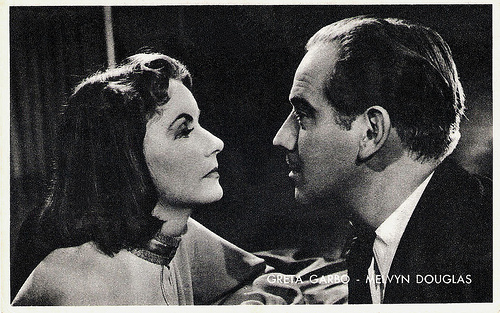
Belgian collector's card by Kwatta, no. C 181. Photo: MGM. Publicity still for Ninotschka (Ernst Lubitsch, 1939) with Greta Garbo and Melvyn Douglas.
Meyer aus Berlin/Meyer from Berlin (Ernst Lubitsch, 1919). Source: Bob Toomey (YouTube)
Trailer for Ninotschka (Ernst Lubitsch, 1939). Source: OscarMovieTrailers (You Tube).
Sources: Ephraim Katz (The Film Encyclopedia), (IMDb), Wikipedia and .

German postcar by Ross Verlag, no. 415/1, 1919-1924. Photo: Rembrandt.

German postcard by Verlag Hermann Leiser, Berlin-Wilm., no. 1926. Photo: Fritz Richard. Collection: Didier Hanson.

German postcard by Photochemie, no. K. 1743. Photo: Alex Binder, Paris. Collection: Marlene Pilaete.

German postcard by Ross Verlag, Berlin, no. 581/4, 1919-1924. Photo: B.B.B. Collection: Didier Hanson. Ernst Lubitsch with Douglas Fairbanks , Charlie Chaplin and Mary Pickford.

German postcard by Ross Verlag, no. 581/5, 1919-1924. Photo: B.B.B. Collection: Didier Hanson. Ernst Lubitsch with Charlie Chaplin , Mary Pickford and Douglas Fairbanks .
Ethnic Jewish Humour
Ernst Lubitsch was born in Berlin, Germany, in 1892. He was the son of Anna (née Lindenstaedt) and Simon Lubitsch, a prosperous tailor. His family was Ashkenazi Jewish, his father born in Grodno and his mother from Wriezen (Oder), outside Berlin.
Ernst was drawn to the stage while participating in plays staged by the Sophien Gymnasium, his Berlin high school, which he quit at 16.
To satisfy both his own urge to act and his father's desire that he take over the family business, he began leading a double life, working as a bookkeeper at his father's store by day and appearing in cabarets and music halls by night.
By 1911, he was a member of Max Reinhardt's renowned Deutsches Theater, where he quickly advanced from bit parts to character leads. To supplement his income, Lubitsch took a job in 1912 as an apprentice and general-purpose handyman at Berlin's Bioscope film studios, and learned silent film acting.
Lubitsch soon made his film debut in Die ideale Gattin/The Ideal Wife (Hanns Heinz Ewers, Marc Henry, 1913) with Lyda Salmanova . The comedy Die Firma heiratetThe Firm Weds (Carl Wilhelm, 1913) with Albert Paulig , and its sequel Der Stolz der Firma/The Pride of the Firm (Carl Wilhelm, 1914) turned him into a popular comedian.
Till 1920, he acted in approximately thirty films. Lubitsch appeared in a series of very successful film comedies as a character named Meyer in which he emphasised ethnic Jewish humour, including Meyer auf der Alm (?, 1913), and Meyer Als Soldat/Meyer as Soldier (?, 1914).
In 1914 he began to write and direct his own films. His first film as a director in was Fräulein Seifenschaum/Miss Soapsuds(1914) and he established his reputation as a director, writer, producer and comedian with the foundation of the Malu-Film company, together with the actor Ernst Matráy .
He made his mark as a serious director with the drama Die Augen der Mumie Ma/The Eyes of the Mummy (Ernst Lubitsch, 1918), starring Pola Negri . He gradually abandoned acting to concentrate on directing and his last film appearance was opposite Pola Negri and Paul Wegener in the drama Sumurun (Ernst Lubitsch, 1920).

With Ossi Oswalda . German postcard by Ross Verlag, Berlin, no. 337/1, 1919-1924. Photo: Zander & Labisch.

German postcard by Photochemie, no. K. 1983. Photo: Union Film. Publicity still for Der Blusen-König (Ernst Lubitsch, 1917). Collection: Didier Hanson.

German postcard by Photochemie, Berlin, no. K. 1999. Photo: Union Film. Ossi Oswalda and Hermann Thimig in the Ossi's Tagebuch (Ernst Lubitsch, 1917).

Henny Porten as Anna Boleyn, in Anna Boleyn (1920). German postcard by Ross Verlag, Berlin, no. 645/3, 1919-1924. Photo: Union Film.

German postcard by Ross Verlag, no. 581/2, 1919-1924. Photo: B.B.B. Collection: Didier Hanson. Ernst Lubitsch with Mary Pickford.

German postcard by Ross Verlag, no. 1523/3, 1927-1928. Photo: Parufamet. Pola Negri in Forbidden Paradise (Ernst Lubitsch, 1924).
Grand Master
As a director, Ernst Lubitsch alternated between escapist comedies and large-scale historical dramas, enjoying great international success with both.
A triumph was Die Austernprinzessin/The Oyster Princess (Ernst Lubitsch, 1919), featuring Ossi Oswalda , a sparkling satire caricaturing American manners.
Ephraim Katz in The Film Encyclopedia : "For the first time he demonstrated the subtle humor and the virtuoso visual wit that would in time become known as 'the Lubitsch Touch'. The style was characterised by a parsimonious compression of ideas and situations into single shots or brief scenes that provided an ironic key to the characters and to the meaning of the entire film."
His reputation as a grand master of world cinema reached a new peak after the release of his spectacles Madame DuBarry/Passion (Ernst Lubitsch, 1919) with Pola Negri , and Anna Boleyn/Deception (Ernst Lubitsch, 1920) starring Henny Porten and Emil Jannings . Both of these films found American distributorship by early 1921.
Madame Du Barry and Anna Boleyn, along with his Carmen/Gypsy Blood (Ernst Lubitsch, 1921) were selected by The New York Times on its list of the 15 most important movies of 1921.
With glowing reviews under his belt, and American money flowing his way, Lubitsch formed his own production company and made the high-budget spectacular Das Weib des Pharao/The Loves of Pharaoh (Ernst Lubitsch, 1921).
In 1922, he married Helene Kraus. They divorced in 1931.

German postcard by Photochemie, Berlin, no. K. 2008. Photo: Union-Film. Publicity still for Wenn vier dasselbe tun/When Four Do the Same (Ernst Lubitsch, 1917), starring Ossi Oswalda as the girl, Fritz Schulz (here on the left) as her lover, and Emil Jannings as her father (here on the right).

German postcard by Photochemie, Berlin, no. K. 2012. Photo: Union Film. Publicity still for Prinz Sami/Prince Sami (Ernst Lubitsch, 1918). Collection: Didier Hanson.

German postcard by Photochemie, Berlin, no. K. 2835. Photo: publicity still for Die Augen der Mumie Ma/The Eyes of the Mummy (Ernst Lubitsch, 1918) with Pola Negri . Collection: Didier Hanson.

German postcard by Ross Verlag, Berlin, no. 611/2. Photo: Union / Ufa. Publicity still for Die Austernprinzessin/The Oyster Princess (Ernst Lubitsch, 1919) with Victor Janson.

German postcard by Ross Verlag, no. 627/6. Photo: Union Film. Publicity still of Reinhold Schünzel and Pola Negri in Madame DuBarry (Ernst Lubitsch, 1919). After the death of king Louis XV ( Emil Jannings ), his minister Choiseul (Schünzel) chases DuBarry (Negri) from the Royal palace.
Hollywood
Ernst Lubitsch's success in Europe brought him to the shores of America to promote Das Weib des Pharao/The Loves of Pharaoh (1922) and he got acquainted with the thriving US film industry.
Lubitsch returned briefly to Germany but soon left for good for Hollywood. He was contracted by Mary Pickford, who wanted him to direct her in Dorothy Vernon of Haddon Hall. Upon arrival, he rejected the project and directed her instead in Rosita (1923).
Director and star clashed during its filming. While the resuly was deemed a failure from her point of view, it was a critical and commercial success. It ended up as the only project that they made together.
A free agent after just one American film, Lubitsch was signed to a remarkable three-year, six-picture contract by Warner Brothers that guaranteed the director his choice of both cast and crew, and full editing control over the final cut.
Settling in America, Lubitsch established his reputation for sophisticated comedy with such stylish films as The Marriage Circle (1924), Lady Windermere's Fan (1925), and So This Is Paris (1926).
Ephraim Katz: "Lubitsch grasped the American psychology with an amazing accuracy and focused his satire on two main themes -- sex and money. With characteristic laconic wit, he depicted sex as a frivolous pastime, a sophisticated game moneyed people play to occupy their hours of leisure. To be safe, he set his plots against foreign backgrounds -- Paris, Vienna, Budapest -- or some mythical land, but the implication was clearly American and audiences rarely failed to recognize themselves or their friends, their manners, their foibles, their weaknesses."
But his films were only marginally profitable for Warner Brothers, and Lubitsch's contract was eventually dissolved by mutual consent, with MGM-Paramount buying out the remainder.
His first film for MGM, The Student Prince in Old Heidelberg (1927) with Ramon Novarro , was well regarded, but also lost money.

German postcard by Ross Verlag, Berlin, no. 635/5, 1919-1924. Photo: Union. Publicity still for Die Puppe/The Doll (Ernst Lubitsch, 1919) with Ossi Oswalda and Hermann Thimig .

German postcard by Ross Verlag, no. 636/4. Photo: Maxim Film. Publicity still for Romeo und Julia im Schnee/Romeo and Juliet in the Snow (Ernst Lubitsch, 1920), with Lotte Neumann (Julia) and Gustav von Wangenheim (Romeo Montekugerl).

German postcard by Ross Verlag no. 639/5. Photo: Messter-Film. Publicity still for Kohlhiesels Töchter/Kohlhiesel's Daughters (Ernst Lubitsch, 1920) with Emil Jannings and Henny Porten .

German postcard by Ross Verlag, Berlin, no. 760/5. Photo: Alex Binder. Publicity still for Die Bergkatze/Wildcat (Ernst Lubitsch, 1921) with Pola Negri .

German postcard by Ross Verlag, Berlin, no. 832/1, 1919-1924. Union Film. Publicity still for Sumurun (Ernst Lubitsch, 1920) with Jenny Hasselqvist aka Jenny Hasselquist.
Musicals
Lubitsch seized upon the advent of talkies to direct musicals. With his first sound film, The Love Parade (1929), starring Maurice Chevalier and Jeanette MacDonald, Lubitsch hit his stride as a maker of worldly musical comedies and earned himself another Oscar nomination.
While most of Lubitsch's silent films had been made for Warner Bros., most of his early sound pictures were for Paramount.
The Love Parade (1929), Monte Carlo (1930), and The Smiling Lieutenant (1931) were hailed by critics as masterpieces of the newly emerging musical genre. Lubitsch served on the faculty of the University of Southern California for a time.
His next film was a romantic comedy, written with Samson Raphaelson, Trouble in Paradise (1932). The cynical comedy was popular both with critics and with audiences.
But it was a project that could only have been made before the enforcement of the Production Code, and after 1935, Trouble in Paradise was withdrawn from circulation. It was not seen again until 1968.
Ernst Lubitsch continued to specialize in comedy, whether with music, as in MGM's opulent The Merry Widow (1934) and Paramount's One Hour with You (1932), or without, as in Design for Living (1933).
He made only one other dramatic film, the anti-war Broken Lullaby/The Man I Killed (1932).
In 1935, he was appointed Paramount's production manager, thus becoming the only major Hollywood director to run a large studio.
But Lubitsch had trouble delegating authority, which was a problem when he was overseeing sixty different films. He was fired after a year on the job, and returned to full-time moviemaking.

German postcard by Ross Verlag, no. 838/1. Photo: Terra Film A.G., Berlin. Publicity still for Rosita (Ernst Lubitsch, 1923).

Ramon Novarro and Norma Shearer. German postcard by Ross Verlag, no. 98/6. Photo: Metro-Goldwyn-Mayer. Publicity still for The Student Prince in Old Heidelberg (Ernst Lubitsch, 1927).

French postcard by Cinémagazine Edition, Paris, no. 794. Photo: Paramount. Publicity still for The Love Parade (Ernst Lubitsch, 1929) with Maurice Chevalier and Jeanette MacDonald.

Dutch-Belgian promotion card for Cacao Van Houten, no. 11 and 12. Printed by N.V. Ned Reclamefabriek. This card was part of a series of promo cards for a quiz by Van Houten Chocolate. The public had to go to stores to guess which film star was on the photo in the shop window. There were 24 photos. At the right we recognized (with the help from a former owner of the card :)) Jack Buchanan and Jeanette MacDonald in Monte Carlo (Ernst Lubitsch, 1930). But who are the actors on the other picture? Name also the title of the film and the production company. In the past you could win a Philips Radio...

Maurice Chevalier and Miriam Hopkins. German postcard by Ross Verlag, no. 5976/1, 1931-1932. Photo: Paramount. Publicity still for The Smiling Lieutenant (Ernst Lubitsch, 1931).
Garbo Laughs!
In 1935 he married his second wife, British actress Vivian Gaye. They had one daughter, Nicola Lubitsch in 1938. And in 1936, he became a naturalized US citizen.
Lubitsch moved to MGM, and directed Greta Garbo in Ninotchka (1939). The famously serious actress' laughing scene in this satirical comedy was heavily promoted by studio publicists with the tagline "Garbo Laughs!"
In 1940, Lubitsch directed The Shop Around the Corner, an artful comedy of cross purposes.
The film reunited Lubitsch with his Merry Widow screenwriter Raphaelson, and starred James Stewart and Margaret Sullavan as a pair of bickering co-workers in Budapest, each unaware that the other is their secret romantic correspondent.
Lubitsch went independent to direct That Uncertain Feeling (1941, a remake of his 1925 film Kiss Me Again), and the dark anti-Nazi farce To Be or Not to Be (1942).
William McPeak at IMDb on To Be or Not to Be (1942): "a biting satire of Nazi tyranny that also poked fun at Lubitsch's own theater roots with the problems and bickering--but also the triumph--of a somewhat raggedy acting troupe in Warsaw during the Nazi occupation. Jack Benny's perfect deadpan humor worked well with the zany vivaciousness of Carole Lombard, and a cast of veteran character actors from both Hollywood and Lubitsch's native Germany provided all the chemistry needed to make this a classic comedy, as well as a fierce statement against the perpetrators of war."
A heart condition curtailed his activity, and he spent much of his time in supervisory capacities. His next film, Heaven Can Wait (1943) was another Raphaelson collaboration.
Then, Lubitsch worked with Edwin Justus Mayer on the scripting process of A Royal Scandal (1945), a remake of Lubitsch's silent film A Forbidden Paradise. The script was written and prepared under Lubitsch, and he was the original director of this film, and directed the rehearsals. He became ill during shooting, so he hired Otto Preminger, another disciple of Max Reinhardt's Viennese theatre work, to do the rest of the shooting.
After A Royal Scandal, Lubitsch regained his health, and directed Cluny Brown (1946), with Charles Boyer and Jennifer Jones.
In 1947, he was awarded a Special Academy Award. Ernst Lubitsch died later that year in Hollywood of a heart attack, his sixth. He was 55.
His last film, That Lady in Ermine (1948) with Betty Grable, was completed by Otto Preminger and released posthumously.

German postcard by Ross Verlag, no. 6732/1, 1931-1932. Photo: Paramount. Publicity still for One Hour with You (Ernst Lubitsch, 1932) with Roland Young, Genevieve Tobin, Jeanette MacDonald, and Maurice Chevalier .

French postcard by Europe, no. 73. Photo: Paramount. Maurice Chevalier and Lily Damita in Une heure près de toi (George Cukor, Ernst Lubitsch, 1932), the French language version of One Hour With You.

German postcard by Ross Verlag, no. 1606/2, 1937-1938. Photo: Paramount. Publicity still for Bluebeard's Eighth Wife (Ernst Lubitsch, 1938) with Claudette Colbert.

Belgian collector's card by Kwatta, no. C 181. Photo: MGM. Publicity still for Ninotschka (Ernst Lubitsch, 1939) with Greta Garbo and Melvyn Douglas.
Meyer aus Berlin/Meyer from Berlin (Ernst Lubitsch, 1919). Source: Bob Toomey (YouTube)
Trailer for Ninotschka (Ernst Lubitsch, 1939). Source: OscarMovieTrailers (You Tube).
Sources: Ephraim Katz (The Film Encyclopedia), (IMDb), Wikipedia and .
Published on May 29, 2018 22:00
May 28, 2018
Roger Duchesne
French film actor Roger Duchesne (1906-1996) appeared in 30 films between 1934 and 1957. He is best remembered as the silver haired gangster Bob in Jean-Pierre Melville's Policier Bob le flambeur/Bob the Gambler (1956).
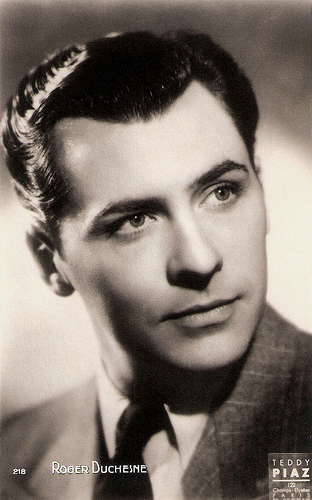
French postcard by Editions O.P., Paris, no 218. Photo: Teddy Piaz.
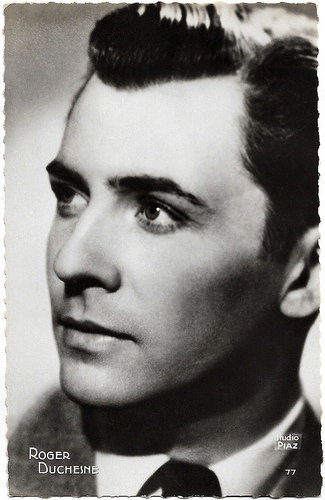
French postcard by Editions P.I., Paris, no. 77. Photo: Studio Piaz.
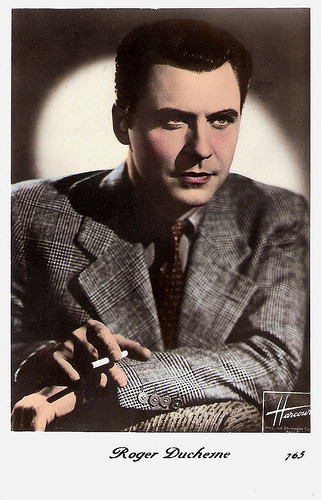
French postcard, no. 775. Photo: Studio Harcourt.
Soldier of Fortune
Roger Duchesne was born as Roger André Charles Jordens in Luxeuil-les-Bains, France in 1906.
In 1934, he started his film career with Vers l'abîme/Towards the abyss (Hans Steinhoff, Serge Véber, 1934) starring Raymond Rouleau and Brigitte Helm , a French language version of the UFA production Die Insel/The Island (Hans Steinhoff, 1934).
He played his first lead in the spy film Les loups entre eux/The Wolves Among Them (Léon Mathot, 1936) opposite Jules Berry . He also co-starred that year in the innovative Le roman d'un tricheur/Confessions of a Cheat (Sacha Guitry, 1936) starring Sacha Guitry himself and his wife Jacqueline Delubac .
James Travers writes at Films de France : “Regarded as one of Sacha Guitry ’s best films, Le Roman d’un tricheur is a hugely entertaining comedy, featuring some unforgettable visual comic gags. Having no dialogue, the film is perhaps best described a silent film with voice-over commentary, in which the film’s central character (the cheat, played by Guitry himself) narrates the story of his life.”
Another interesting film was the comedy Messieurs les ronds de cuir/The Bureaucrats (Yves Mirande, 1937) with Lucien Baroux and Arletty .
Duchesne also appeared in Le Golem/The Golem (Julien Duvivier, 1936). Hal Erickson notes at AllMovie : “Filmed in Czechoslovakia, this French-language adaptation of the oft-filmed Jewish folk tale The Golem was one of the most expensive productions ever made in that country. The story, which some have cited as a precursor to Frankenstein, is set in Prague's Jewish Ghetto. Fearing an anti-Semitic pogrom at the hands of Emperor Rudolf ( Harry Baur ), Rabbi Jacob (Charles Dorat) magically brings a statue to life to protect his people from harm.”
In the espionage drama Gibraltar/It Happened in Gibraltar (Fyodor Otsep a.k.a. Fedor Ozep, 1938), he co-starred with Viviane Romance , and Erich von Stroheim , who also co-wrote the script. He also appeared in the melodrama Tempête Sur L'Asie/Storm over Asia (Richard Oswald, 1938) which featured Conrad Veidt as a soldier of fortune who spearheads an expedition in Mongolia in hopes of finding hitherto untapped oil reserves.
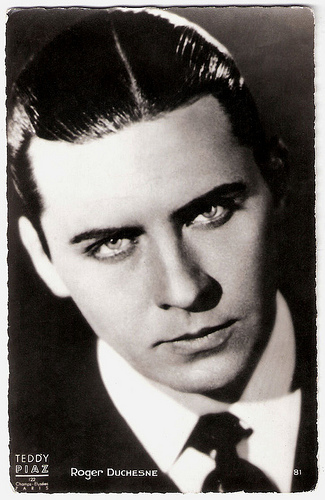
French postcard by Editions O.P., Paris, no. 81. Photo: Teddy Piaz.
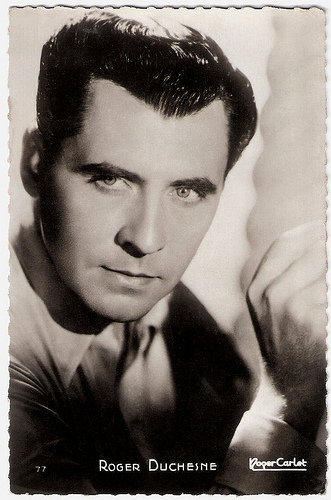
French postcard by Editions P.I., Paris, no. 77. Photo: Roger Carlet.
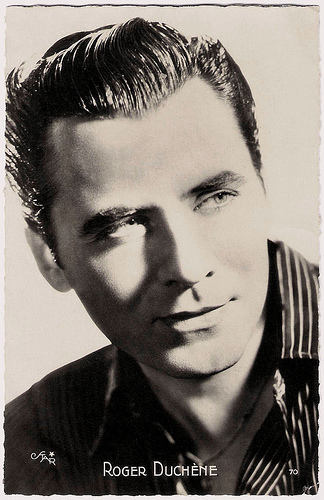
French postcard by Editions O.P., Paris, no. 70. Photo: Star.
Gestapo
Roger Duchesne continued to work after the Nazis had occupied France. He co-starred in Montmartre-sur-Seine (Georges Lacombe, 1941) starring Édith Piaf and Jean-Louis Barrault .
Other popular films during the war period were La femme perdue/The Lost Woman (Jean Choux, 1942) starring Renée Saint-Cyr , and the entertaining Fernandel farce Adrien (Fernandel, 1943).
In September 1944, Duchesne was arrested while hiding in Paris, accused of having worked for the Gestapo. Then followed a gap in his film career of more than ten years.
Roger Duchesne made a great come-back with Bob le flambeur/Bob the Gambler (1956), a gangster film directed by Jean-Pierre Melville. He starred in the title role as the old, silver-haired gangster and gambler Bob, living in the Montmartre district of Paris, who experiences a run of bad luck that leaves him nearly broke. Duchesne made of Bob a gentleman with scruples.
The film is often considered a Film Noir and precursor to the French Nouvelle Vague (New Wave) because of its use of handheld camera and a single jump cut. The engaging and witty film was only the director's fourth film, made before Melville had access to the bigger budgets and the bigger stars ( Jean-Paul Belmondo , Alain Delon ) of his later pictures. However, Bob le Flambeur was not a great commercial success on its first release.
Duchesne made only one more film, Marchands de filles/Sellers of Girls (Maurice Cloche, 1957). In this crime drama, a poor woman ( Agnès Laurent ) finds herself the victim of a group of white slavers and drug smugglers. The criminals take the woman to South America, where she teams up with a mysterious stranger ( Georges Marchal ) in an effort to defeat her captors and find her way back home.
Marchands de filles would be Roger Duchesne's final film. Not much is known about his further life. He died in 1996 in Les Mureaux, France, at the age of 90.
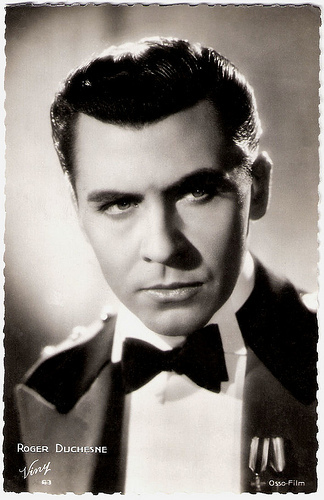
French postcard by Viny, no. 63. Photo: Osso-Film.
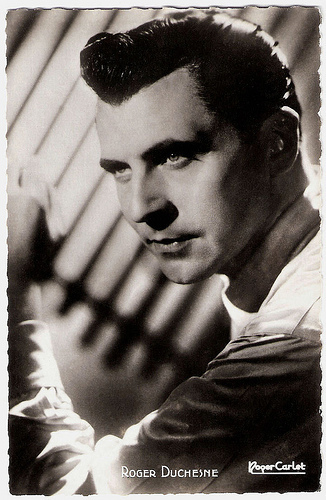
French postcard by Editions P.I., Paris. Photo: Roger Carlet.
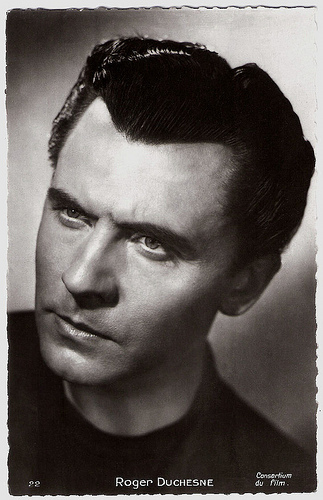
French postcard, no. 22. Photo: Consortium du film.
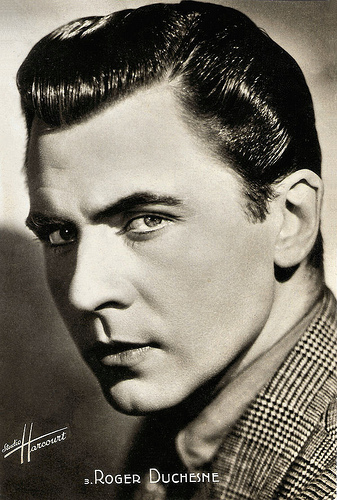
French postcard by S.E.R.P., Paris, no. 3. Photo: Studio Harcourt. Sadly, a former owner cut the edges of the card.
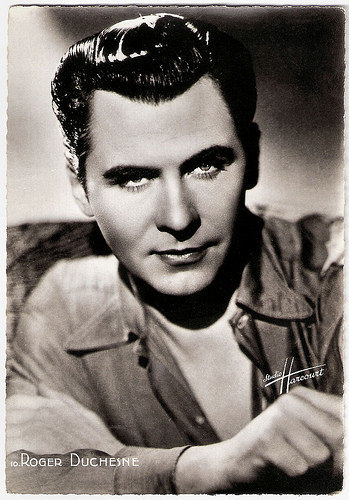
French postcard by S.E.R.P., Paris, no. 10. Photo: Studio Harcourt.
Sources: Hal Erickson (AllMovie), James Travers (Films de France), Wikipedia (English and French) and .

French postcard by Editions O.P., Paris, no 218. Photo: Teddy Piaz.

French postcard by Editions P.I., Paris, no. 77. Photo: Studio Piaz.

French postcard, no. 775. Photo: Studio Harcourt.
Soldier of Fortune
Roger Duchesne was born as Roger André Charles Jordens in Luxeuil-les-Bains, France in 1906.
In 1934, he started his film career with Vers l'abîme/Towards the abyss (Hans Steinhoff, Serge Véber, 1934) starring Raymond Rouleau and Brigitte Helm , a French language version of the UFA production Die Insel/The Island (Hans Steinhoff, 1934).
He played his first lead in the spy film Les loups entre eux/The Wolves Among Them (Léon Mathot, 1936) opposite Jules Berry . He also co-starred that year in the innovative Le roman d'un tricheur/Confessions of a Cheat (Sacha Guitry, 1936) starring Sacha Guitry himself and his wife Jacqueline Delubac .
James Travers writes at Films de France : “Regarded as one of Sacha Guitry ’s best films, Le Roman d’un tricheur is a hugely entertaining comedy, featuring some unforgettable visual comic gags. Having no dialogue, the film is perhaps best described a silent film with voice-over commentary, in which the film’s central character (the cheat, played by Guitry himself) narrates the story of his life.”
Another interesting film was the comedy Messieurs les ronds de cuir/The Bureaucrats (Yves Mirande, 1937) with Lucien Baroux and Arletty .
Duchesne also appeared in Le Golem/The Golem (Julien Duvivier, 1936). Hal Erickson notes at AllMovie : “Filmed in Czechoslovakia, this French-language adaptation of the oft-filmed Jewish folk tale The Golem was one of the most expensive productions ever made in that country. The story, which some have cited as a precursor to Frankenstein, is set in Prague's Jewish Ghetto. Fearing an anti-Semitic pogrom at the hands of Emperor Rudolf ( Harry Baur ), Rabbi Jacob (Charles Dorat) magically brings a statue to life to protect his people from harm.”
In the espionage drama Gibraltar/It Happened in Gibraltar (Fyodor Otsep a.k.a. Fedor Ozep, 1938), he co-starred with Viviane Romance , and Erich von Stroheim , who also co-wrote the script. He also appeared in the melodrama Tempête Sur L'Asie/Storm over Asia (Richard Oswald, 1938) which featured Conrad Veidt as a soldier of fortune who spearheads an expedition in Mongolia in hopes of finding hitherto untapped oil reserves.

French postcard by Editions O.P., Paris, no. 81. Photo: Teddy Piaz.

French postcard by Editions P.I., Paris, no. 77. Photo: Roger Carlet.

French postcard by Editions O.P., Paris, no. 70. Photo: Star.
Gestapo
Roger Duchesne continued to work after the Nazis had occupied France. He co-starred in Montmartre-sur-Seine (Georges Lacombe, 1941) starring Édith Piaf and Jean-Louis Barrault .
Other popular films during the war period were La femme perdue/The Lost Woman (Jean Choux, 1942) starring Renée Saint-Cyr , and the entertaining Fernandel farce Adrien (Fernandel, 1943).
In September 1944, Duchesne was arrested while hiding in Paris, accused of having worked for the Gestapo. Then followed a gap in his film career of more than ten years.
Roger Duchesne made a great come-back with Bob le flambeur/Bob the Gambler (1956), a gangster film directed by Jean-Pierre Melville. He starred in the title role as the old, silver-haired gangster and gambler Bob, living in the Montmartre district of Paris, who experiences a run of bad luck that leaves him nearly broke. Duchesne made of Bob a gentleman with scruples.
The film is often considered a Film Noir and precursor to the French Nouvelle Vague (New Wave) because of its use of handheld camera and a single jump cut. The engaging and witty film was only the director's fourth film, made before Melville had access to the bigger budgets and the bigger stars ( Jean-Paul Belmondo , Alain Delon ) of his later pictures. However, Bob le Flambeur was not a great commercial success on its first release.
Duchesne made only one more film, Marchands de filles/Sellers of Girls (Maurice Cloche, 1957). In this crime drama, a poor woman ( Agnès Laurent ) finds herself the victim of a group of white slavers and drug smugglers. The criminals take the woman to South America, where she teams up with a mysterious stranger ( Georges Marchal ) in an effort to defeat her captors and find her way back home.
Marchands de filles would be Roger Duchesne's final film. Not much is known about his further life. He died in 1996 in Les Mureaux, France, at the age of 90.

French postcard by Viny, no. 63. Photo: Osso-Film.

French postcard by Editions P.I., Paris. Photo: Roger Carlet.

French postcard, no. 22. Photo: Consortium du film.

French postcard by S.E.R.P., Paris, no. 3. Photo: Studio Harcourt. Sadly, a former owner cut the edges of the card.

French postcard by S.E.R.P., Paris, no. 10. Photo: Studio Harcourt.
Sources: Hal Erickson (AllMovie), James Travers (Films de France), Wikipedia (English and French) and .
Published on May 28, 2018 22:00
May 27, 2018
Ursula Thiess
German film star Ursula Thiess (1924–2010) was dubbed by Life magazine as the ‘most beautiful woman in the world’. Howard Hughes offered her a long-term contract to RKO, but five years later she gave up her acting career after marrying Robert Taylor. The glamorous, luscious looking actress had only starred in a handful of Hollywood movies.
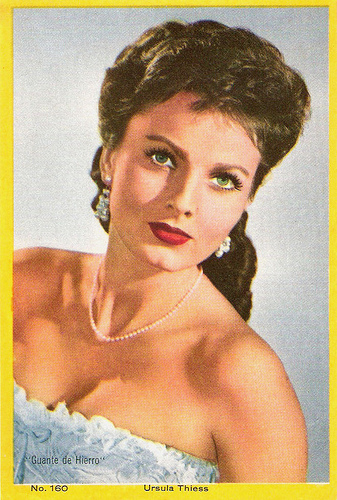
Mexican collectors card, no. 160. Photo: publicity still for The Iron Glove (William Castle, 1954).
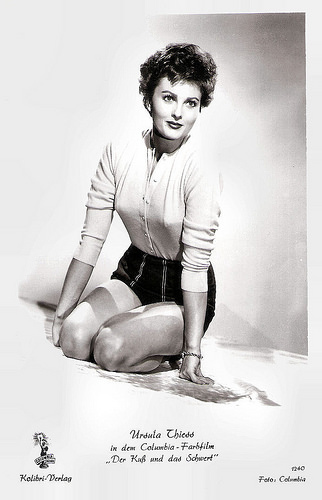
German postcard by Kolibri-Verlag, no. 1240. Photo: Columbia. Publicity still for The Iron Glove (William Castle, 1954).
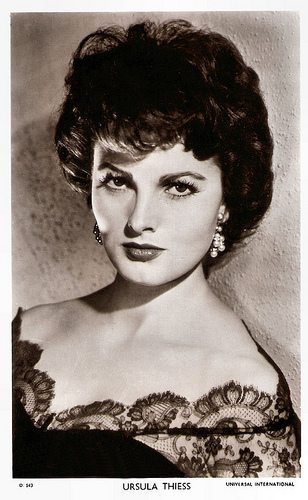
British postcard in the Picturegoer Series, London, no. D. 543. Photo: Universal International.
Unusual Beauty
Ursula Thiess was born as Ursula Schmidt in Hamburg, Germany in 1924 to Wilhelmine Lange and Hans Schmidt, who was the manager of a printing shop.
In 1939, she refused to join the paramilitary Hitler Youth movement, and therefore the authorities of the Third Reich took her out of school and made her work as a farm labourer for one year.
After that she began her entertainment career appearing on the stage and dubbing female voices in foreign films. She met and married German film producer Georg Otto Thiess in 1942. They would have two children, Manuela (1944) and Michael (1946), but the relatively unhappy marriage dissolved in 1947.
In 1948, she began a modeling career in Berlin. As Ursula Thiess she was featured in many German magazines, and the photos of the unusual beauty appeared on several covers. She also had a small role in the German film Nachtwache/Keepers of the Night (Harald Braun, 1949) starring Luise Ullrich .
Film mogul Howard Hughes had spotted her and urged her to leave postwar Germany. The trip coincided with a cover shoot in Life magazine. The magazine called her the ‘most beautiful woman in the world’ and Hughes signed her for a long-term contract to RKO.
Her debut film was as a half caste English/India(n) girl in the outdoor drama Monsoon (Rod Amateau, 1952) opposite the frequently bare-chested George Nader . She was voted Most Promising Star of 1952 by Modern Screen Magazine along with Marilyn Monroe .
She then co-starred with Robert Stack in the clunky adventure film The Iron Glove (William Castle, 1954) and appeared opposite Rock Hudson in the more enjoyable Bengal Brigade (Laslo Benedek, 1954).
The following years she appeared with Glenn Ford in The Americano (William Castle, 1955), and with Robert Mitchum in Bandido (Richard Fleischer, 1956), set during the Mexican civil war of 1916.
In these run-of-the-mill action adventure stories she was mainly a (highly) decorative element, supporting the leading men. She also was a popular pin-up in film fan magazines. At IMDb , Gary Brumburgh describes her as a ‘Glamorous brunette beauty’: “Gorgeous was too tame a word for this foreigner stunner.”
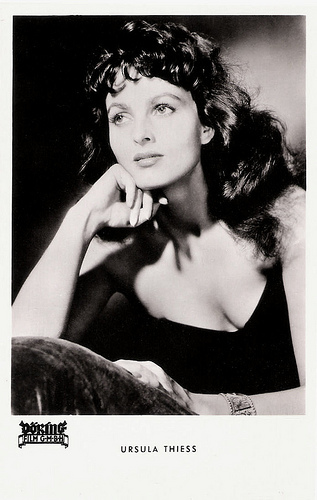
German postcard by Kunst und Bild, Berlin, no. A 955. Photo: Döring Film G.m.b.H. Publicity still for Monsoon (Rod Amateau, 1952).
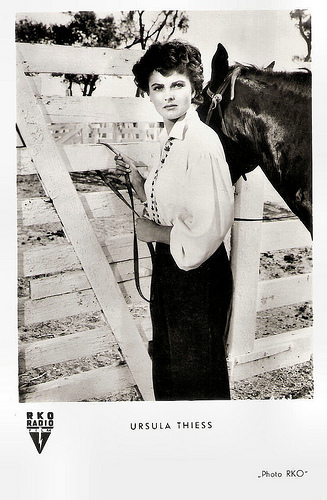
German postcard by Kunst und Bild, Berlin, no. I 410. Photo: RKO. Publicity still for The Americano (William Castle, 1955).
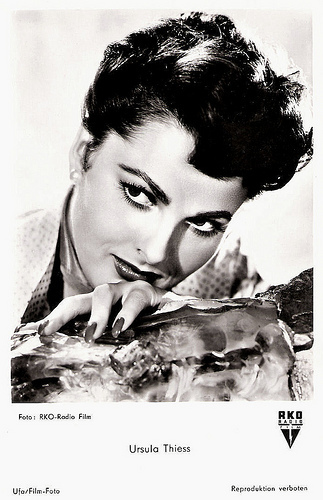
German postcard by Universum-Film AG (UFA), Berlin-Tempelhof, no. FK 779. Photo: RKO-Radio Film.
Blind Date
Ursula Thiess had met handsome film star Robert Taylor on a blind date in April 1952 after his marriage to actress Barbara Stanwyck had ended the previous year. They married two years later.
When she was up to co-star with Clark Gable in The King and Four Queens (Raoul Walsh, 1956) at Gable's request, she turned it down to focus on her family. The Taylors had two children Terry (1955) and Tessa (1959). They moved with Ursula's two children from her previous marriage, to their ranch in Brentwood, California, in 1956, and lived there until Taylor's death from cancer in 1969.
She did appear in three episodes of her husband's TV series The Detectives Starring Robert Taylor (1959) during its first season, playing a police reporter who has a brief affair with Taylor's character. Ursula's two children, Manuela and Michael, had many adjustment problems adapting to their new life, and were often in trouble with the police, causing the family to suffer bad publicity as a result.
Michael, who had served a year in a German prison for attempting to poison his natural father, died shortly before Robert Taylor's death, in 1969. He had committed suicide by overdose at the age of 24. Ursula discovered him dead when she stopped by his motel to drop him off some medication.
After Taylor's death, she was obliged to sell their ranch. Thiess did some film and TV appearances before bowing out completely. Her last film was the completely overlooked Left Hand of Gemini (1972) with Richard Egan and Ian McShane.
She moved to Bel Air, and married film distributor Marshal Schacker in 1973. They stayed married until his death from cancer in 1986. Ursula had undergone surgery for a benign brain tumour in 1979, but recovered to lead a normal life, often visiting Hawaii while her children pursued their careers. She wrote her autobiography, ...But I Have Promises to Keep: My Life Before, With and After Robert Taylor.
In 2010, Ursula Thiess died of natural causes in an assisted living care facility in Burbank, US at the age of 86. She was survived by three of her four children, Manuela, Terry, and Tessa.
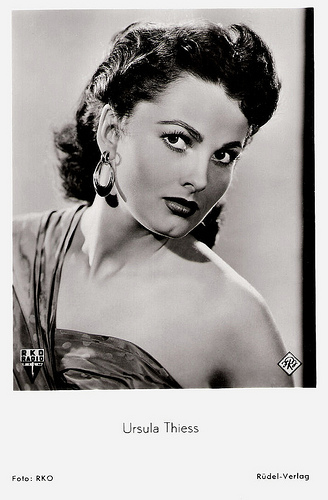
German postcard by Rüdel-Verlag, Hamburg-Bergedorff, no 522. Photo: RKO.
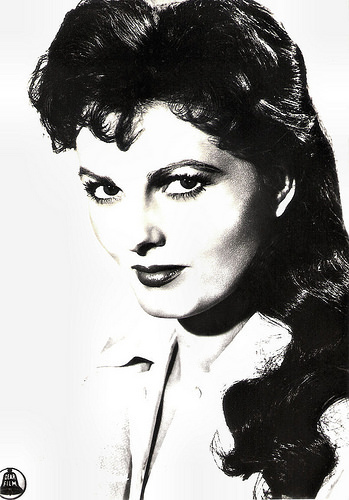
Italian postcard by Bromofoto, Milano, no. 1372. Photo: Dear Film. Publicity still for Bandido! (Richard Fleischer, 1956).
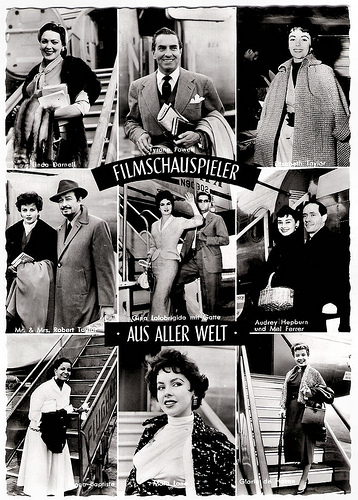
German postcard by Kunst und Film Verlag H. Lukow, Hannover, no. L2/1042. Caption: Filmschauspieler aus aller Welt (Film actors from around the world).
From top left to down right: Linda Darnell, Tyrone Power , Elizabeth Taylor , Robert Taylor and Ursula Thiess, Gina Lollobrigida and her husband Milko Skofic, Audrey Hepburn and Mel Ferrer, Mona Baptiste, Mara Lane and Gloria DeHaven.
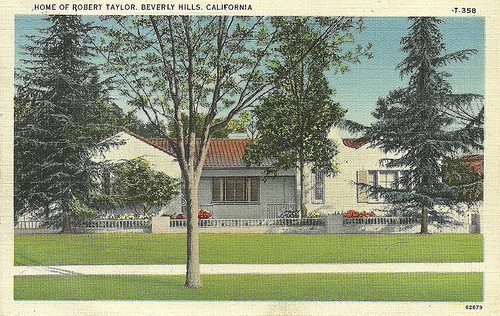
Beverly Hills House of the Taylor family, 510, Roxbury Drive, Los Angeles, USA.
Sources: (IMDb), E.A. Kral (Beatrice Daily Sun), The Telegraph, Wikipedia, and .

Mexican collectors card, no. 160. Photo: publicity still for The Iron Glove (William Castle, 1954).

German postcard by Kolibri-Verlag, no. 1240. Photo: Columbia. Publicity still for The Iron Glove (William Castle, 1954).

British postcard in the Picturegoer Series, London, no. D. 543. Photo: Universal International.
Unusual Beauty
Ursula Thiess was born as Ursula Schmidt in Hamburg, Germany in 1924 to Wilhelmine Lange and Hans Schmidt, who was the manager of a printing shop.
In 1939, she refused to join the paramilitary Hitler Youth movement, and therefore the authorities of the Third Reich took her out of school and made her work as a farm labourer for one year.
After that she began her entertainment career appearing on the stage and dubbing female voices in foreign films. She met and married German film producer Georg Otto Thiess in 1942. They would have two children, Manuela (1944) and Michael (1946), but the relatively unhappy marriage dissolved in 1947.
In 1948, she began a modeling career in Berlin. As Ursula Thiess she was featured in many German magazines, and the photos of the unusual beauty appeared on several covers. She also had a small role in the German film Nachtwache/Keepers of the Night (Harald Braun, 1949) starring Luise Ullrich .
Film mogul Howard Hughes had spotted her and urged her to leave postwar Germany. The trip coincided with a cover shoot in Life magazine. The magazine called her the ‘most beautiful woman in the world’ and Hughes signed her for a long-term contract to RKO.
Her debut film was as a half caste English/India(n) girl in the outdoor drama Monsoon (Rod Amateau, 1952) opposite the frequently bare-chested George Nader . She was voted Most Promising Star of 1952 by Modern Screen Magazine along with Marilyn Monroe .
She then co-starred with Robert Stack in the clunky adventure film The Iron Glove (William Castle, 1954) and appeared opposite Rock Hudson in the more enjoyable Bengal Brigade (Laslo Benedek, 1954).
The following years she appeared with Glenn Ford in The Americano (William Castle, 1955), and with Robert Mitchum in Bandido (Richard Fleischer, 1956), set during the Mexican civil war of 1916.
In these run-of-the-mill action adventure stories she was mainly a (highly) decorative element, supporting the leading men. She also was a popular pin-up in film fan magazines. At IMDb , Gary Brumburgh describes her as a ‘Glamorous brunette beauty’: “Gorgeous was too tame a word for this foreigner stunner.”

German postcard by Kunst und Bild, Berlin, no. A 955. Photo: Döring Film G.m.b.H. Publicity still for Monsoon (Rod Amateau, 1952).

German postcard by Kunst und Bild, Berlin, no. I 410. Photo: RKO. Publicity still for The Americano (William Castle, 1955).

German postcard by Universum-Film AG (UFA), Berlin-Tempelhof, no. FK 779. Photo: RKO-Radio Film.
Blind Date
Ursula Thiess had met handsome film star Robert Taylor on a blind date in April 1952 after his marriage to actress Barbara Stanwyck had ended the previous year. They married two years later.
When she was up to co-star with Clark Gable in The King and Four Queens (Raoul Walsh, 1956) at Gable's request, she turned it down to focus on her family. The Taylors had two children Terry (1955) and Tessa (1959). They moved with Ursula's two children from her previous marriage, to their ranch in Brentwood, California, in 1956, and lived there until Taylor's death from cancer in 1969.
She did appear in three episodes of her husband's TV series The Detectives Starring Robert Taylor (1959) during its first season, playing a police reporter who has a brief affair with Taylor's character. Ursula's two children, Manuela and Michael, had many adjustment problems adapting to their new life, and were often in trouble with the police, causing the family to suffer bad publicity as a result.
Michael, who had served a year in a German prison for attempting to poison his natural father, died shortly before Robert Taylor's death, in 1969. He had committed suicide by overdose at the age of 24. Ursula discovered him dead when she stopped by his motel to drop him off some medication.
After Taylor's death, she was obliged to sell their ranch. Thiess did some film and TV appearances before bowing out completely. Her last film was the completely overlooked Left Hand of Gemini (1972) with Richard Egan and Ian McShane.
She moved to Bel Air, and married film distributor Marshal Schacker in 1973. They stayed married until his death from cancer in 1986. Ursula had undergone surgery for a benign brain tumour in 1979, but recovered to lead a normal life, often visiting Hawaii while her children pursued their careers. She wrote her autobiography, ...But I Have Promises to Keep: My Life Before, With and After Robert Taylor.
In 2010, Ursula Thiess died of natural causes in an assisted living care facility in Burbank, US at the age of 86. She was survived by three of her four children, Manuela, Terry, and Tessa.

German postcard by Rüdel-Verlag, Hamburg-Bergedorff, no 522. Photo: RKO.

Italian postcard by Bromofoto, Milano, no. 1372. Photo: Dear Film. Publicity still for Bandido! (Richard Fleischer, 1956).

German postcard by Kunst und Film Verlag H. Lukow, Hannover, no. L2/1042. Caption: Filmschauspieler aus aller Welt (Film actors from around the world).
From top left to down right: Linda Darnell, Tyrone Power , Elizabeth Taylor , Robert Taylor and Ursula Thiess, Gina Lollobrigida and her husband Milko Skofic, Audrey Hepburn and Mel Ferrer, Mona Baptiste, Mara Lane and Gloria DeHaven.

Beverly Hills House of the Taylor family, 510, Roxbury Drive, Los Angeles, USA.
Sources: (IMDb), E.A. Kral (Beatrice Daily Sun), The Telegraph, Wikipedia, and .
Published on May 27, 2018 22:00
May 26, 2018
Marie Déa
French actress Marie Déa (1912-1992) became famous through two classics of the French cinema, Marcel Carné 's Les Visiteurs du Soir/The Devil's Envoys (1942) and Jean Cocteau's Orphée/Orpheus (1950).
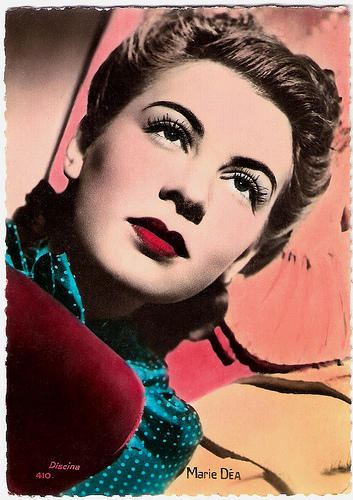
French postcard, no. 410. Photo: Discina.
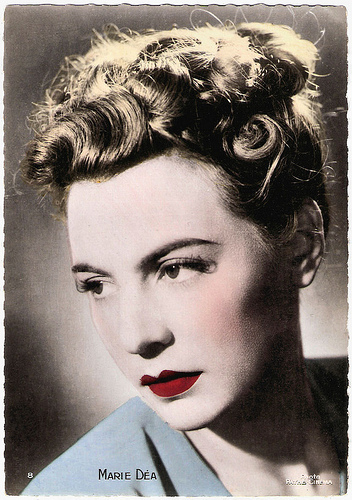
French postcard by Editions P.I., Paris, no. 8. Photo: Pathé Cinema.
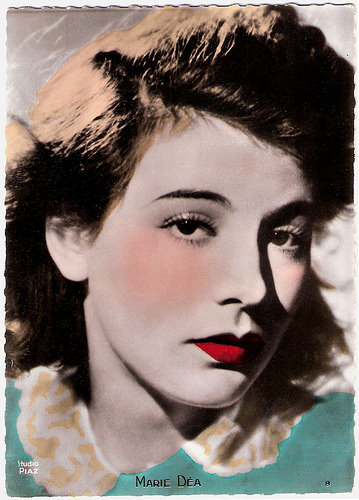
French postcard by Editions P.I., Paris, no. 8. Photo: Studio Paz.
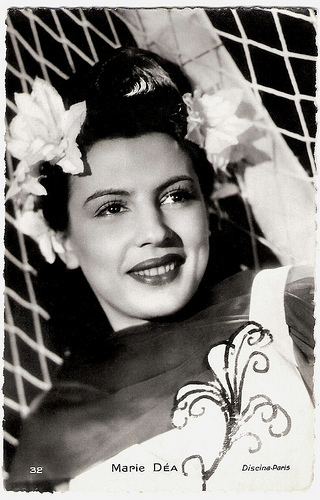
French postcard by Edit. Chantal, Rueil, no. 32. Photo: Discina, Paris.
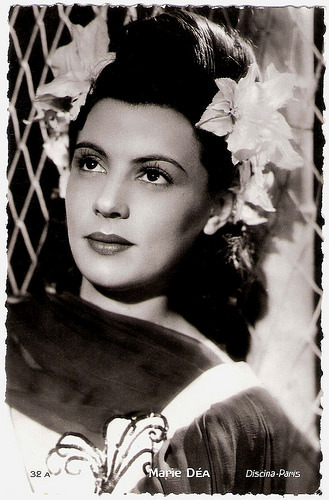
French postcard by Edit. Chantal, Rueil, no. 32 A. Photo: Discina, Paris.
No-nonsense and Gutsy
Marie Déa was born as Odette Alice Marie Deupès in Nanterre, France in 1912.
After completing a law studies she followed a drama course and began her career with small roles. In 1939 she appeared in the film Nord-Atlantique/North Atlantic (Maurice Cloche, 1939), which introduced her to the public.
In her next film Pièges/Personal Column (Robert Siodmak, 1939) she starred opposite Maurice Chevalier . In this excellent thriller, Déa plays an amateur detective, whose friend was a victim of a maniac who finds his preys through small ads.
James Travers at Films de France : “Marie Déa is impressive as the no-nonsense and gutsy Adrienne, a refreshing contrast to the feeble, two-dimensional screen heroines of the time. In many ways, Pièges is the template for the crime thriller which would become one of the most popular genres in French cinema in subsequent decades.”
Next she was the leading lady in Premier bal/First Ball (Christian-Jaque, 1941) opposite François Périer, Histoire de rire/Foolish Husbands (Marcel L’Herbier, 1941) with Fernand Gravey , and Le journal tombe à cinq heures/The newspaper falls at five o'clock (Georges Lacombe, 1942) starring Pierre Fresnay .
In 1942 she appeared in Les visiteurs du soir/The Devil's Envoys (Marcel Carné, 1942), one of the timeless masterpieces which came out of the fruitful collaboration between director Marcel Carné and screenwriter Jacques Prévert. The film was hailed as a major cinematographic achievement upon its release in 1942 and was one of the most popular films made under the Nazi Occupation.
In this tale set in the Middle Ages, Marie Déa plays a baron’s daughter with a pure heart who is lured from her fiancé by a handsome minstrel ( Alain Cuny ), who is sent by the devil. The minstrel is caught in his own trap and falls in love, and the couple then has to fight the devil.
At IMDb , DB Dumonteil writes: “During the German occupation, it was an alibi: the Devil was meant to represent Hitler and the two lovers the Resistance. But for the people at the time, their hints at French plight were so disguised - or else, it would have been banned by the censorship -, they only saw the escapist movie which they did need.”
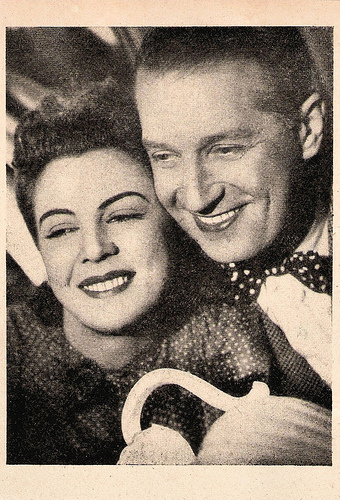
German postcard. Photo: IFA. Publicity still for Pièges/Personal Column (Robert Siodmak, 1939) with Maurice Chevalier .
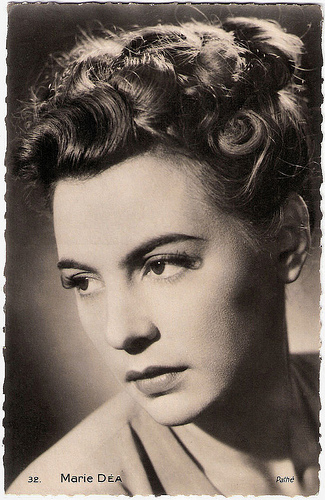
French postcard by Editions E.C., Paris, no. 32. Photo: Pathé.
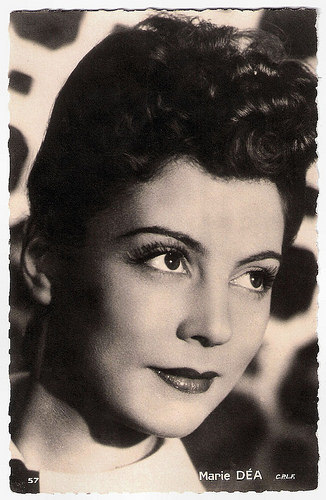
French postcard by Ed. ChantaI, Rueil, Paris, no. 57. Photo: C.P.L.F.
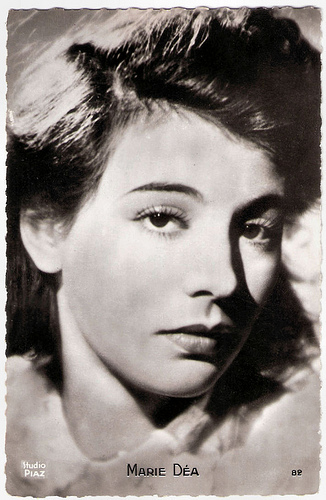
French postcard by Editions P.I., Paris, no. 82. Photo: Studio Paz.
Magical and Entertaining
After the war, Marie Déa continued to play leading roles in French films, but most of them were quite mediocre. Interesting is the remake La maternelle (Henri Diamant-Berger, 1949), in which Déa played a headmistress of a kindergarten in poverty-stricken Ménilmontant. In Spain she appeared opposite Fernando Rey in Aventuras de Juan Lucas/Adventures of Juan Lucas (Rafael Gil, 1949).
Then she appeared in another classic of the French cinema, Jean Cocteau’s Orphée/Orpheus (1950), an update of the Greek myth of Orpheus and Eurydice in post-war France. Déa played Eurydice to Jean Marais ’ modern Orpheus.
RobertF97 at IMDb: "Writer-director Jean Cocteau turns the everyday world into a magical realm. Mirrors turn to pools which are portals to other worlds, car radios pick up coded messages from Death's World. In less talented hands than Cocteau's, the delicate fantasy could have easily become ridiculous but he handles it with brilliance and the film works perfectly. Here Cocteau creates a truly poetic film. The story is magical and entertaining and the film is filled with wondrously surreal images (particularly striking is the frequent use of filming an action performed backwards, and then reversing it which creates a very strange impression).”
During the 1950s, Déa only played incidentally supporting parts in films, such as in the comedy La jument verte/The Green Mare (Claude Autant-Lara, 1959) starring Bourvil .
During the following decade she was seen with Fernandel in L'assassin est dans l'annuaire/Assassin in the Phonebook (Léo Joannon, 1962), and in the crime drama Le glaive et la balance/The Sword and the Balance (André Cayatte, 1963) starring Anthony Perkins . During the 1960s and 1970s, she regularly worked for TV.
Among her later film appearances are Mariage/Marriage (Claude Lelouch, 1974) with Bulle Ogier, L'homme pressé/Man in a Hurry (Edouard Molinaro, 1977) starring Alain Delon , and Subversion (Stanislav Stanojevic, 1979).
In 1992, Marie Déa died accidentally after a fire in Paris. She was 79.
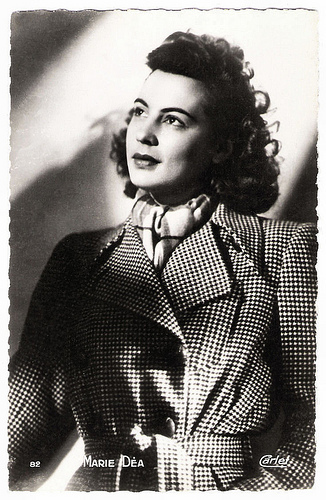
French postcard by Editions P.I., Paris, no. 82. Photo: Carlet.
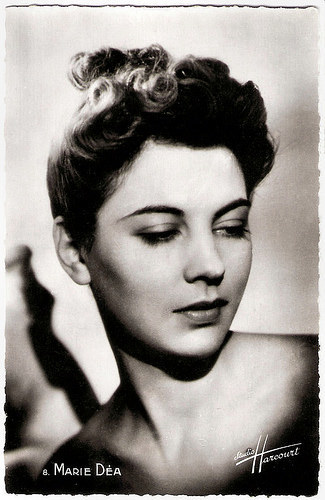
French postcard by SERP, Paris, no. 8. Photo: Studio Harcourt.
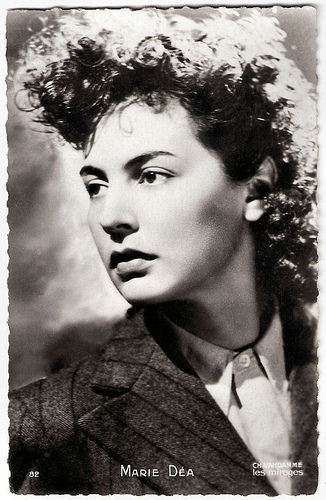
French postcard by Editions P.I., Paris, no. 82. Photo: Ch. Vandamme, Les Mirages.
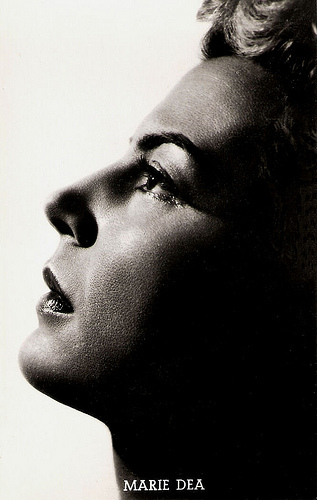
French postcard. Photo: MGM.
Sources: James Travers (Films de France), DB Dumonteil (IMDb), Robert F87 (IMDb), Wikipedia (French) and .

French postcard, no. 410. Photo: Discina.

French postcard by Editions P.I., Paris, no. 8. Photo: Pathé Cinema.

French postcard by Editions P.I., Paris, no. 8. Photo: Studio Paz.

French postcard by Edit. Chantal, Rueil, no. 32. Photo: Discina, Paris.

French postcard by Edit. Chantal, Rueil, no. 32 A. Photo: Discina, Paris.
No-nonsense and Gutsy
Marie Déa was born as Odette Alice Marie Deupès in Nanterre, France in 1912.
After completing a law studies she followed a drama course and began her career with small roles. In 1939 she appeared in the film Nord-Atlantique/North Atlantic (Maurice Cloche, 1939), which introduced her to the public.
In her next film Pièges/Personal Column (Robert Siodmak, 1939) she starred opposite Maurice Chevalier . In this excellent thriller, Déa plays an amateur detective, whose friend was a victim of a maniac who finds his preys through small ads.
James Travers at Films de France : “Marie Déa is impressive as the no-nonsense and gutsy Adrienne, a refreshing contrast to the feeble, two-dimensional screen heroines of the time. In many ways, Pièges is the template for the crime thriller which would become one of the most popular genres in French cinema in subsequent decades.”
Next she was the leading lady in Premier bal/First Ball (Christian-Jaque, 1941) opposite François Périer, Histoire de rire/Foolish Husbands (Marcel L’Herbier, 1941) with Fernand Gravey , and Le journal tombe à cinq heures/The newspaper falls at five o'clock (Georges Lacombe, 1942) starring Pierre Fresnay .
In 1942 she appeared in Les visiteurs du soir/The Devil's Envoys (Marcel Carné, 1942), one of the timeless masterpieces which came out of the fruitful collaboration between director Marcel Carné and screenwriter Jacques Prévert. The film was hailed as a major cinematographic achievement upon its release in 1942 and was one of the most popular films made under the Nazi Occupation.
In this tale set in the Middle Ages, Marie Déa plays a baron’s daughter with a pure heart who is lured from her fiancé by a handsome minstrel ( Alain Cuny ), who is sent by the devil. The minstrel is caught in his own trap and falls in love, and the couple then has to fight the devil.
At IMDb , DB Dumonteil writes: “During the German occupation, it was an alibi: the Devil was meant to represent Hitler and the two lovers the Resistance. But for the people at the time, their hints at French plight were so disguised - or else, it would have been banned by the censorship -, they only saw the escapist movie which they did need.”

German postcard. Photo: IFA. Publicity still for Pièges/Personal Column (Robert Siodmak, 1939) with Maurice Chevalier .

French postcard by Editions E.C., Paris, no. 32. Photo: Pathé.

French postcard by Ed. ChantaI, Rueil, Paris, no. 57. Photo: C.P.L.F.

French postcard by Editions P.I., Paris, no. 82. Photo: Studio Paz.
Magical and Entertaining
After the war, Marie Déa continued to play leading roles in French films, but most of them were quite mediocre. Interesting is the remake La maternelle (Henri Diamant-Berger, 1949), in which Déa played a headmistress of a kindergarten in poverty-stricken Ménilmontant. In Spain she appeared opposite Fernando Rey in Aventuras de Juan Lucas/Adventures of Juan Lucas (Rafael Gil, 1949).
Then she appeared in another classic of the French cinema, Jean Cocteau’s Orphée/Orpheus (1950), an update of the Greek myth of Orpheus and Eurydice in post-war France. Déa played Eurydice to Jean Marais ’ modern Orpheus.
RobertF97 at IMDb: "Writer-director Jean Cocteau turns the everyday world into a magical realm. Mirrors turn to pools which are portals to other worlds, car radios pick up coded messages from Death's World. In less talented hands than Cocteau's, the delicate fantasy could have easily become ridiculous but he handles it with brilliance and the film works perfectly. Here Cocteau creates a truly poetic film. The story is magical and entertaining and the film is filled with wondrously surreal images (particularly striking is the frequent use of filming an action performed backwards, and then reversing it which creates a very strange impression).”
During the 1950s, Déa only played incidentally supporting parts in films, such as in the comedy La jument verte/The Green Mare (Claude Autant-Lara, 1959) starring Bourvil .
During the following decade she was seen with Fernandel in L'assassin est dans l'annuaire/Assassin in the Phonebook (Léo Joannon, 1962), and in the crime drama Le glaive et la balance/The Sword and the Balance (André Cayatte, 1963) starring Anthony Perkins . During the 1960s and 1970s, she regularly worked for TV.
Among her later film appearances are Mariage/Marriage (Claude Lelouch, 1974) with Bulle Ogier, L'homme pressé/Man in a Hurry (Edouard Molinaro, 1977) starring Alain Delon , and Subversion (Stanislav Stanojevic, 1979).
In 1992, Marie Déa died accidentally after a fire in Paris. She was 79.

French postcard by Editions P.I., Paris, no. 82. Photo: Carlet.

French postcard by SERP, Paris, no. 8. Photo: Studio Harcourt.

French postcard by Editions P.I., Paris, no. 82. Photo: Ch. Vandamme, Les Mirages.

French postcard. Photo: MGM.
Sources: James Travers (Films de France), DB Dumonteil (IMDb), Robert F87 (IMDb), Wikipedia (French) and .
Published on May 26, 2018 22:00
May 25, 2018
Carl Möhner
Handsome Austrian film actor Carl Möhner (1921–2005) appeared in over 40 films between 1949 and 1976, including the French gangster classic Du rififi chez les hommes/Rififi (1955).
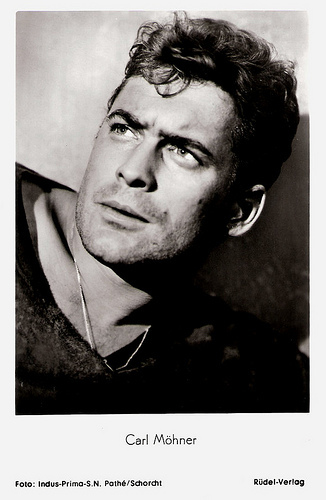
German postcard by Rüdel-Verlag, Hamburg-Bergedorff, no. 1529. Photo: Indus / Prima-S.N. / Pathé / Schorcht. Publicity still for Du rififi chez les hommes/Rififi (Jules Dassin, 1955).
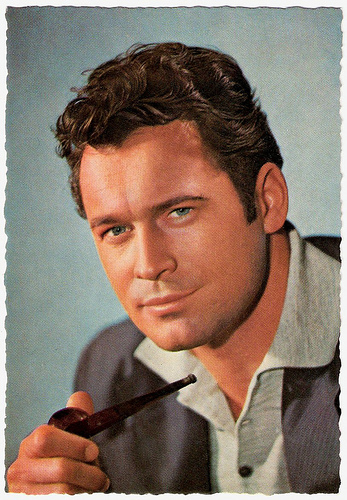
German postcard by WS-Druck, Wanne-Eickel, no. F 65. Photo: Bayer.
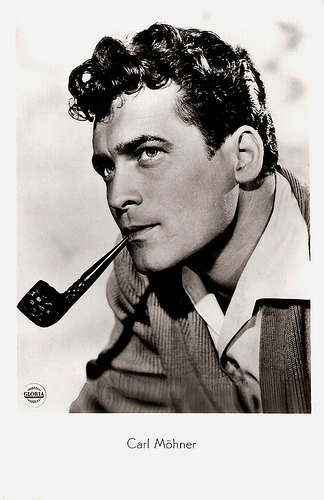
German postcard by F.J. Rüdel, Hamburg-Bergedorf. Photo: Gloria.
Perfect Robbery Goes Wrong
Carl Martin Rudolf Möhner (sometimes Karl Mohner) was born in Wien (Vienna), Austria, in 1921.
He visited the theatre school in his hometown in 1937 and went on to work in several German and Austrian theatres. World War II interrupted his career.
After the war he made his film debut in the drama Vagabunden/Vagabonds (Rolf Hansen, 1949) with Paula Wessely . Next he appeared in a supporting part in Pünktchen und Anton/Punktchen and Anton (Thomas Engel, 1953), based on the popular children’s book by Erich Kästner.
In 1954 he had his breakthrough in Die Leitze Bruecke/The Last Bridge (Helmut Käutner, 1954) filmed in a manner resembling Italian neorealism. The film starring Maria Schell and Bernhard Wicki won the International Jury Prize at the Cannes Film Festival and was a commercial success.
During the following years Möhner had a busy international film career. Among his best known films are the classic French gangster film Du rififi chez les hommes/Rififi (Jules Dassin, 1955) - one of the best ‘perfect robbery goes wrong’ films, and the WW II thriller Sink the Bismarck (Lewis Gilbert, 1960) in which he played the feared Captain Ernest Lindemann of the fabled German battleship Bismarck which had to be destroyed by the British navy.
In Germany he appeared in Wo die alten Wälder rauschen/Where the old forests rustle (Alfons Stummer, 1956) with Willy Fritsch , Die Geierwally/The Geierwally (Frantisek Cáp, 1956) opposite Barbara Rütting, and Weißer Holunder/Elder White (Paul May, 1957) with Germaine Damar .
In France he again appeared opposite Jean Servais in another fine thriller by Jules Dassin, Celui qui doit mourir/He Who Must Die (1957). In the UK he played in the hospital-set drama Behind the Mask (Brian Desmond-Hurst, 1958) with Vanessa Redgrave, and the war drama The Camp on Blood Island (Val Guest, 1958).
In Turkey, he wrote and directed Istanbul macerasi/The Istanbul Adventure (1958). He also appeared opposite Jayne Mansfield in the British crime drama The Challenge/It Takes a Thief (John Gilling, 1960).
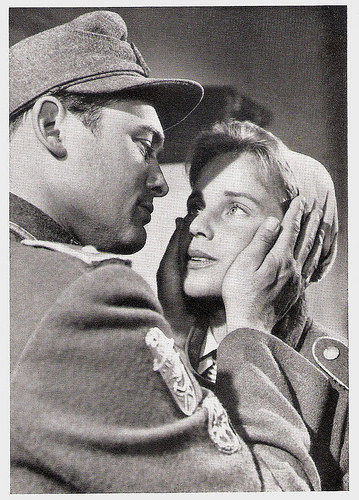
German collectors card. Photo: publicity still for Die Letzte Brücke/The Last Bridge (Helmut Käutner, 1954) with Maria Schell .
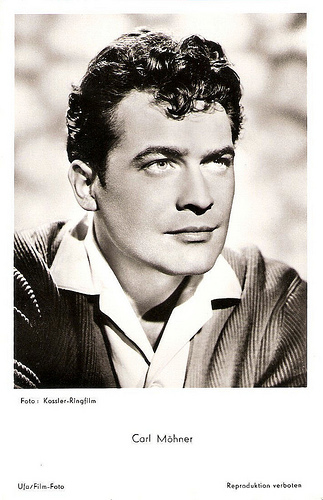
German postcard by Ufa, no. FK 1723. Photo: Kossler/Ringfilm.
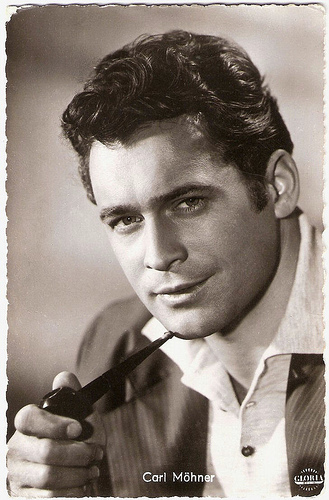
German postcard by Kolibri-Verlag G.m.b.H, Minden/Westf., no. 2309. Photo: Gloria. Publicity still for Wo die alten Wälder rauschen//Where the old forests rustle (1956).
Campy Euro-trash
By the early 1960s, Carl Möhner began to dedicate himself to painting. Soon he had exhibitions in several European cities. In 1963 he won the gold medal in the IX Premio Internationale de Pittura San Vitto Romano.
Later on, he was awarded several times more. His style is characterised as ‘simple’ and ‘childlike innocent’.
In Italy he starred in the Peplum Il Crollo di Roma/The Fall of Rome (Antonio Margheriti aka Anthony M. Dawson, 1963).
Möhner also appeared in three Euro-Westerns: Jim il Primo/The Last Gun (Sergio Bergonzelli aka Serge Bergon, 1964) with Cameron Mitchell, L'uomo dalla pistola d'oro/The Man Who Came to Kill (Alfonso Balcázar, 1965), and 30 Winchester per El Diabolo/30 Winchesters for El Diablo (Frank G. Carroll, 1967).
He appeared in campy euro-trash as the shocker Cave of the Living Dead (Akos Rathonyi, 1965), the sexploitation classic Carmen, Baby (Radley Metzger, 1967), and Nazi-sexploiter Eine Armee Gretchen/She Devils of the SS (Erwin C. Dietrich, 1974) featuring Birgit Bergen .
His final film was the French drama Une Femme à Sa Fenetre/A Woman at her Window (Pierre Granier-Deferre, 1976) starring Romy Schneider .
Then Möhner retired from the film business, and moved to Texas to work on his paintings. Carl Möhner died in McAllen, Texas from Parkinson's disease. He was 83. Since 1978, Möhner was married to Wilma Langhamer and they had two sons, Gunther and Gernot Möhner, who also worked as an actor.
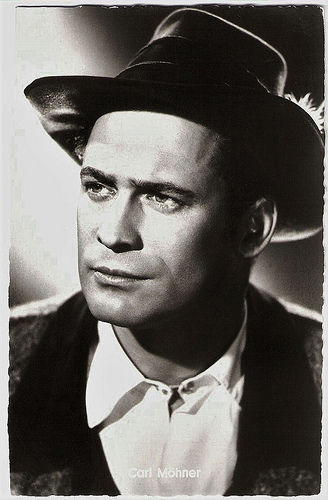
German postcard by Kolibri Verlag G.m.b.H., Minden/Westf., no. 2322. Photo: Ostermayr / Unitas. Publicity still for Der Geierwally/Vulture Wally (Frantisek Cáp, 1956).
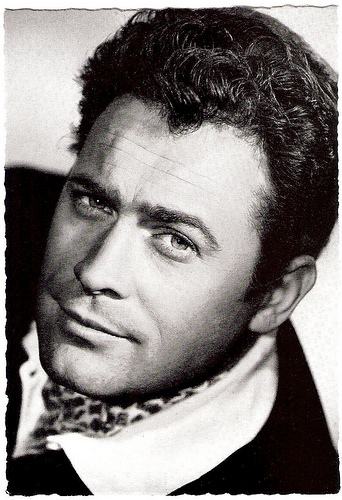
German postcard by WS-Druck, Wanne-Eickel, no. 259. Photo: Bayer/Divina/Gloria.
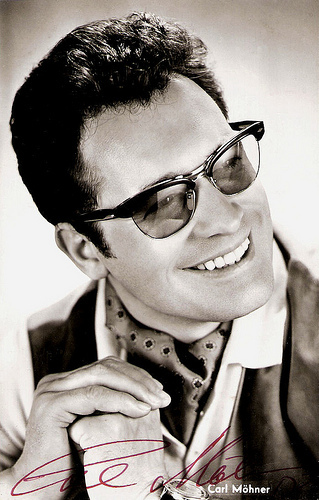
German postcard distributed by Rodenstock-Sonnenbrille. Photo: Rodenstock/Roth. In his film Weisser Holunder/White Elder (1957) Carl Möhner wore Rodenstock sunglasses.
Sources: Carl Mohner Artist.com, Tom B. (Westerns All’Italiana), Hal Erickson (AllMovie), Wikipedia (German and English), and .

German postcard by Rüdel-Verlag, Hamburg-Bergedorff, no. 1529. Photo: Indus / Prima-S.N. / Pathé / Schorcht. Publicity still for Du rififi chez les hommes/Rififi (Jules Dassin, 1955).

German postcard by WS-Druck, Wanne-Eickel, no. F 65. Photo: Bayer.

German postcard by F.J. Rüdel, Hamburg-Bergedorf. Photo: Gloria.
Perfect Robbery Goes Wrong
Carl Martin Rudolf Möhner (sometimes Karl Mohner) was born in Wien (Vienna), Austria, in 1921.
He visited the theatre school in his hometown in 1937 and went on to work in several German and Austrian theatres. World War II interrupted his career.
After the war he made his film debut in the drama Vagabunden/Vagabonds (Rolf Hansen, 1949) with Paula Wessely . Next he appeared in a supporting part in Pünktchen und Anton/Punktchen and Anton (Thomas Engel, 1953), based on the popular children’s book by Erich Kästner.
In 1954 he had his breakthrough in Die Leitze Bruecke/The Last Bridge (Helmut Käutner, 1954) filmed in a manner resembling Italian neorealism. The film starring Maria Schell and Bernhard Wicki won the International Jury Prize at the Cannes Film Festival and was a commercial success.
During the following years Möhner had a busy international film career. Among his best known films are the classic French gangster film Du rififi chez les hommes/Rififi (Jules Dassin, 1955) - one of the best ‘perfect robbery goes wrong’ films, and the WW II thriller Sink the Bismarck (Lewis Gilbert, 1960) in which he played the feared Captain Ernest Lindemann of the fabled German battleship Bismarck which had to be destroyed by the British navy.
In Germany he appeared in Wo die alten Wälder rauschen/Where the old forests rustle (Alfons Stummer, 1956) with Willy Fritsch , Die Geierwally/The Geierwally (Frantisek Cáp, 1956) opposite Barbara Rütting, and Weißer Holunder/Elder White (Paul May, 1957) with Germaine Damar .
In France he again appeared opposite Jean Servais in another fine thriller by Jules Dassin, Celui qui doit mourir/He Who Must Die (1957). In the UK he played in the hospital-set drama Behind the Mask (Brian Desmond-Hurst, 1958) with Vanessa Redgrave, and the war drama The Camp on Blood Island (Val Guest, 1958).
In Turkey, he wrote and directed Istanbul macerasi/The Istanbul Adventure (1958). He also appeared opposite Jayne Mansfield in the British crime drama The Challenge/It Takes a Thief (John Gilling, 1960).

German collectors card. Photo: publicity still for Die Letzte Brücke/The Last Bridge (Helmut Käutner, 1954) with Maria Schell .

German postcard by Ufa, no. FK 1723. Photo: Kossler/Ringfilm.

German postcard by Kolibri-Verlag G.m.b.H, Minden/Westf., no. 2309. Photo: Gloria. Publicity still for Wo die alten Wälder rauschen//Where the old forests rustle (1956).
Campy Euro-trash
By the early 1960s, Carl Möhner began to dedicate himself to painting. Soon he had exhibitions in several European cities. In 1963 he won the gold medal in the IX Premio Internationale de Pittura San Vitto Romano.
Later on, he was awarded several times more. His style is characterised as ‘simple’ and ‘childlike innocent’.
In Italy he starred in the Peplum Il Crollo di Roma/The Fall of Rome (Antonio Margheriti aka Anthony M. Dawson, 1963).
Möhner also appeared in three Euro-Westerns: Jim il Primo/The Last Gun (Sergio Bergonzelli aka Serge Bergon, 1964) with Cameron Mitchell, L'uomo dalla pistola d'oro/The Man Who Came to Kill (Alfonso Balcázar, 1965), and 30 Winchester per El Diabolo/30 Winchesters for El Diablo (Frank G. Carroll, 1967).
He appeared in campy euro-trash as the shocker Cave of the Living Dead (Akos Rathonyi, 1965), the sexploitation classic Carmen, Baby (Radley Metzger, 1967), and Nazi-sexploiter Eine Armee Gretchen/She Devils of the SS (Erwin C. Dietrich, 1974) featuring Birgit Bergen .
His final film was the French drama Une Femme à Sa Fenetre/A Woman at her Window (Pierre Granier-Deferre, 1976) starring Romy Schneider .
Then Möhner retired from the film business, and moved to Texas to work on his paintings. Carl Möhner died in McAllen, Texas from Parkinson's disease. He was 83. Since 1978, Möhner was married to Wilma Langhamer and they had two sons, Gunther and Gernot Möhner, who also worked as an actor.

German postcard by Kolibri Verlag G.m.b.H., Minden/Westf., no. 2322. Photo: Ostermayr / Unitas. Publicity still for Der Geierwally/Vulture Wally (Frantisek Cáp, 1956).

German postcard by WS-Druck, Wanne-Eickel, no. 259. Photo: Bayer/Divina/Gloria.

German postcard distributed by Rodenstock-Sonnenbrille. Photo: Rodenstock/Roth. In his film Weisser Holunder/White Elder (1957) Carl Möhner wore Rodenstock sunglasses.
Sources: Carl Mohner Artist.com, Tom B. (Westerns All’Italiana), Hal Erickson (AllMovie), Wikipedia (German and English), and .
Published on May 25, 2018 22:00
May 24, 2018
Editions O.P.
French publisher Editions O.P., based in Paris, published postcards in two formats, as you can see below. The bigger formats were probably published before and during the war. After the war O.P. started counting again with the smaller formats. Most of the O.P. postcards were in black and white, but for this post we chose 15 hand-coloured gems.
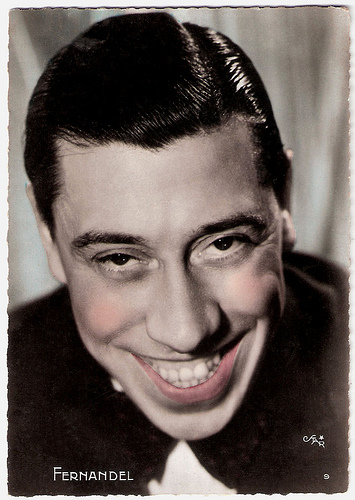
Fernandel . French postcard by Editions O.P., Paris, no. 9. Photo: Star.
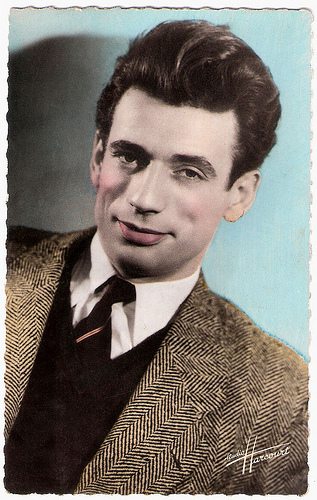
Yves Montand . French postcard by Editions O.P., Paris, no. 11. Photo: Studio Harcourt.
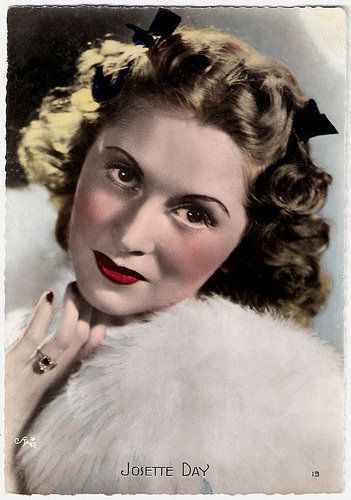
Josette Day . French postcard by Editions O.P., Paris, no. 15. Photo: Star.
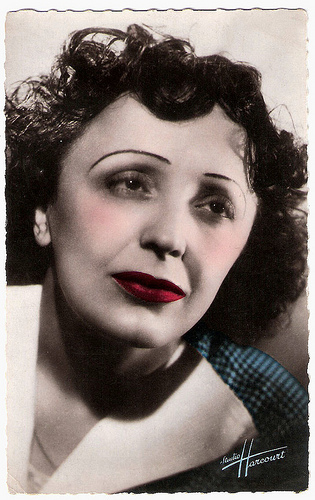
Édith Piaf. French postcard by Editions O.P., Paris, no. 18. Photo: Studio Harcourt.
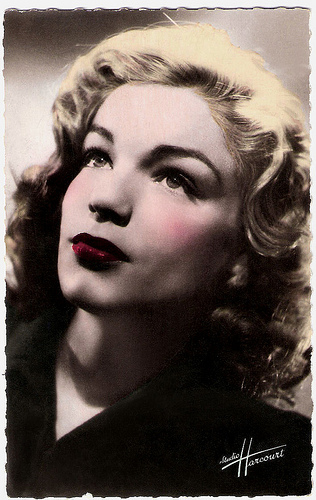
Simone Signoret . French postcard by Editions O.P., no. 19. Photo: Studio Harcourt.
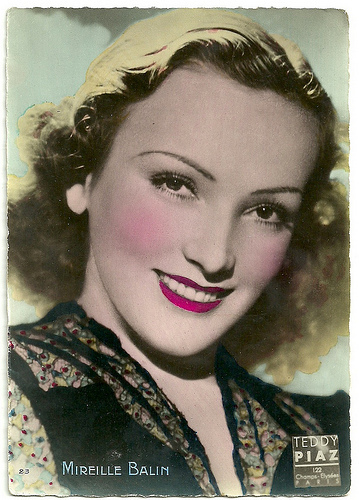
Mireille Balin . French postcard by Editions O.P., Paris, no. 23. Photo: Teddy Piaz.
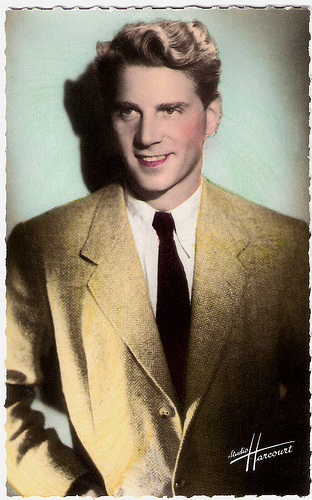
Jean-Pierre Aumont. French postcard by Editions O.P., Paris no. 45. Photo: Studio Harcourt.
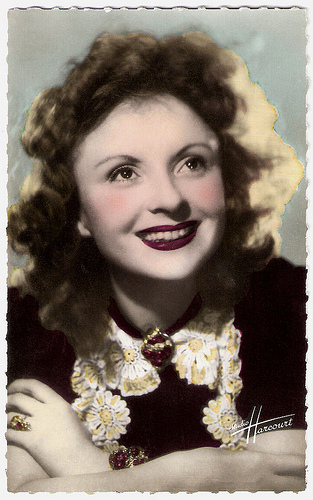
Odette Joyeux . French postcard by Editions O.P., Paris, no. 46. Photo: Studio Harcourt.
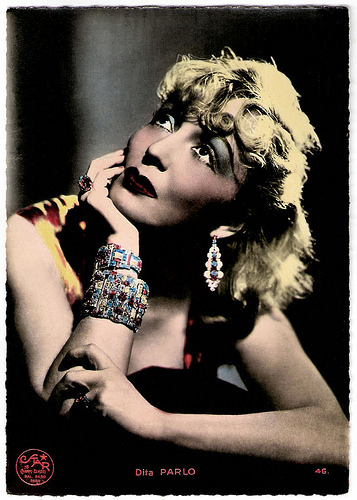
Dita Parlo . French postcard by Editions O.P., Paris, no. 46. Photo: Star.
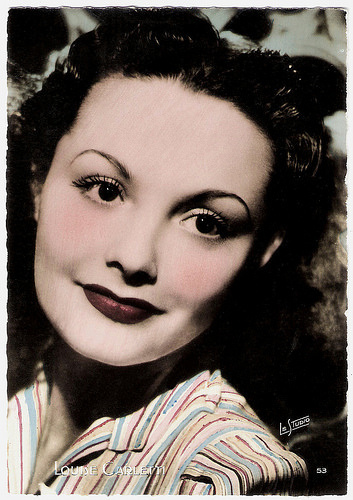
Louise Carletti . French postcard by Editions O.P., Paris, no. 53. Photo: Le Studio.
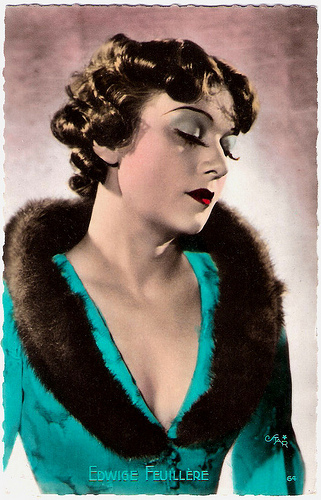
Edwige Feuillère . French postcard by Editions O.P., Paris, no. 64. Photo: Star.
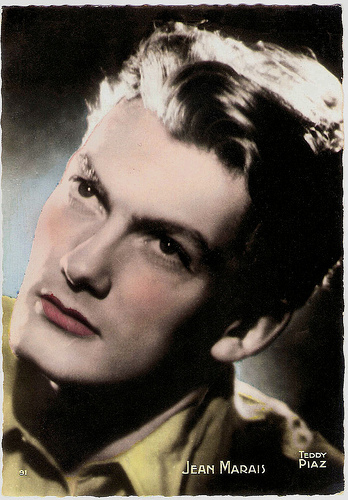
Jean Marais . French postcard by Editions O.P., Paris, no. 91. Photo: Teddy Piaz.
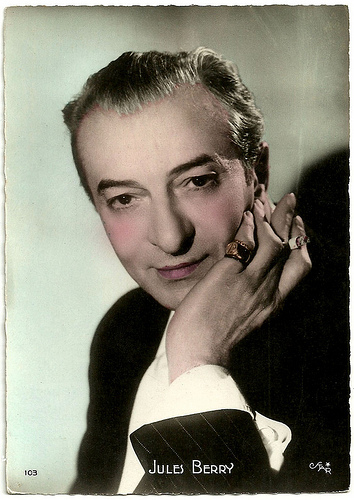
Jules Berry . French postcard by Editions O.P., Paris, no. 103. Photo: Star.
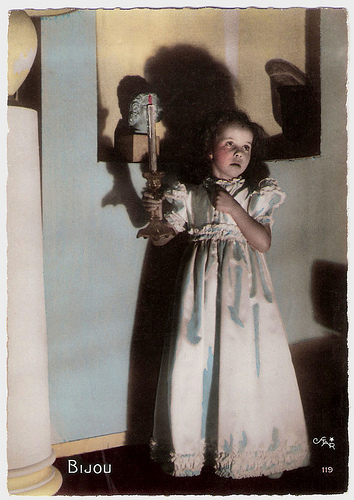
Bijou . French postcard by Editions O.P., Paris, no. 119. Photo: Star.
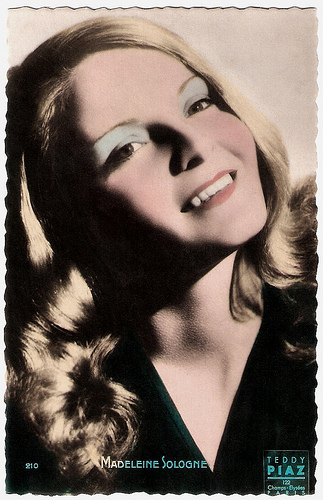
Madeleine Sologne . French postcard by Editions O.P., Paris, no. 210. Photo: Teddy Piaz.
This is - for now - the final post in our series on publishers of film star postcards .
Source: Mark Goffee (Ross Verlag).

Fernandel . French postcard by Editions O.P., Paris, no. 9. Photo: Star.

Yves Montand . French postcard by Editions O.P., Paris, no. 11. Photo: Studio Harcourt.

Josette Day . French postcard by Editions O.P., Paris, no. 15. Photo: Star.

Édith Piaf. French postcard by Editions O.P., Paris, no. 18. Photo: Studio Harcourt.

Simone Signoret . French postcard by Editions O.P., no. 19. Photo: Studio Harcourt.

Mireille Balin . French postcard by Editions O.P., Paris, no. 23. Photo: Teddy Piaz.

Jean-Pierre Aumont. French postcard by Editions O.P., Paris no. 45. Photo: Studio Harcourt.

Odette Joyeux . French postcard by Editions O.P., Paris, no. 46. Photo: Studio Harcourt.

Dita Parlo . French postcard by Editions O.P., Paris, no. 46. Photo: Star.

Louise Carletti . French postcard by Editions O.P., Paris, no. 53. Photo: Le Studio.

Edwige Feuillère . French postcard by Editions O.P., Paris, no. 64. Photo: Star.

Jean Marais . French postcard by Editions O.P., Paris, no. 91. Photo: Teddy Piaz.

Jules Berry . French postcard by Editions O.P., Paris, no. 103. Photo: Star.

Bijou . French postcard by Editions O.P., Paris, no. 119. Photo: Star.

Madeleine Sologne . French postcard by Editions O.P., Paris, no. 210. Photo: Teddy Piaz.
This is - for now - the final post in our series on publishers of film star postcards .
Source: Mark Goffee (Ross Verlag).
Published on May 24, 2018 22:00
May 23, 2018
Wo die Lerche singt (1918)
Wo die Lerche singt/Where the Lark Sings (Hubert Marischka, 1918) is the first film adaptation of the 1918 operetta of the same name by Hungarian composer Franz Lehár. Director Hubert Marischka was a popular Operetta star and director in Vienna and made contact early on with the new medium of film, in which he worked as actor, director and screenwriter.
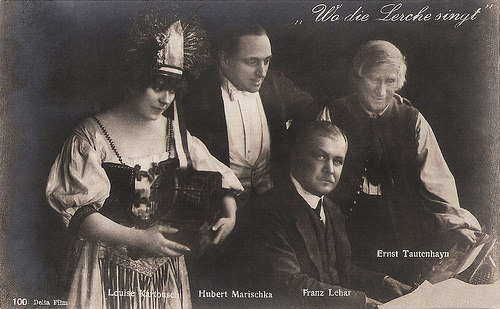
German postcard by B.K.W.I., no. 100. Photo: Delta-Film. Publicity still for Wo die Lerche singt/Where the Lark Sings (Hubert Marischka, 1918). From left to right: Louise Kartousch, director/actor Hubert Marischka, composer Franz Lehár and Ernst Tautenhayn.

German postcard by B.K.W.I., no. 103. Photo: Delta-Film. Publicity still for Wo die Lerche singt/Where the Lark Sings (Hubert Marischka, 1918) with Ernst Tautenhayn.
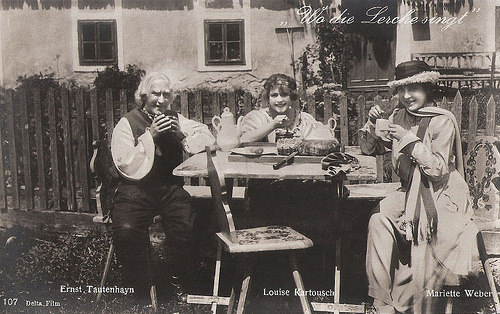
German postcard by B.K.W.I., no. 107. Photo: Delta-Film. Publicity still for Wo die Lerche singt/Where the Lark Sings (Hubert Marischka, 1918) with Ernst Tautenhayn, Louise Kartousch and Mariette Weber.
A country girl in the big city
The libretto of the operetta Wo die Lerche singt by A. M. Willner and Heinz Reichert was inspired by the stage play Dorf und Stadt (Village and City) by Charlotte Birch-Pfeiffer.
The operetta premiered at the Royal Opera in Budapest on 1 January 1918. It was one of Franz Lehár's most successful wartime operettas.
Margit, a young Hungarian country girl (in the film played by Louise Kartousch) travels to a big city where she is seduced and then abandoned by an artist (Hubert Marischka).
Eventually she returns home to the countryside "where the larks sing" and is reconciled with her peasant fiance Pista (Otto Langer). Ernst Tautenhayn played Margit's uncle, the old farmer Törö Pá.
In 1936 the operetta was again adapted into an Operetta film, Wo die Lerche singt/Where the Lark Sings (Carl Lamac, 1936) starring Márta Eggerth . It was a co-production between Hungary, Germany and Switzerland.
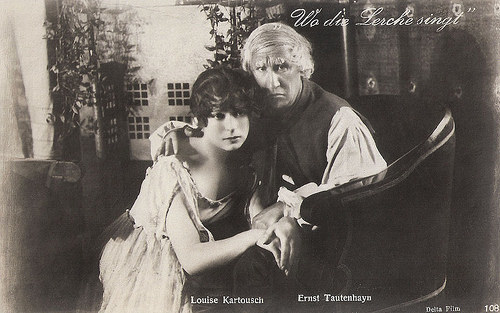
German postcard by B.K.W.I., no. 108. Photo: Delta-Film. Publicity still for Wo die Lerche singt/Where the Lark Sings (Hubert Marischka, 1918) with Louise Kartousch and Ernst Tautenhayn.
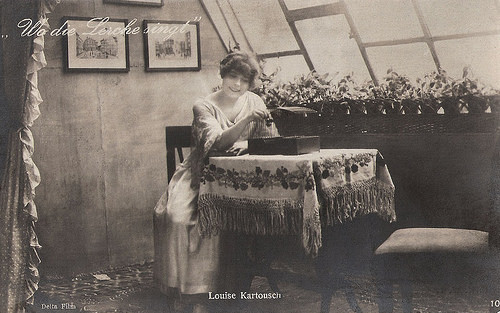
German postcard by B.K.W.I., no. 109 Photo: Delta-Film. Publicity still for Wo die Lerche singt/Where the Lark Sings (Hubert Marischka, 1918) with Louise Kartousch.
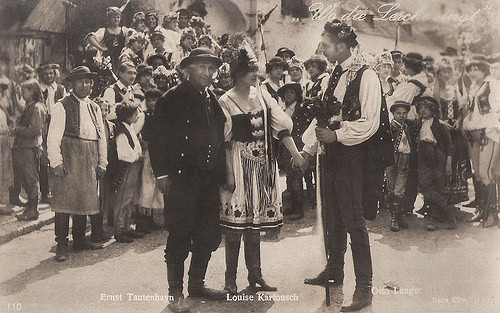
German postcard by B.K.W.I., no. 110. Photo: Delta-Film. Publicity still for Wo die Lerche singt/Where the Lark Sings (Hubert Marischka, 1918) with Ernst Tautenhayn, Louise Kartousch and Otto Langer.
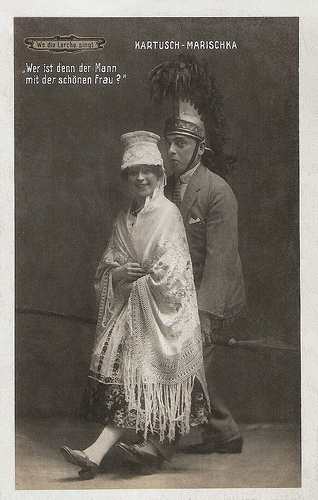
German postcard by B.K.W.L. Photo: Ludwig Gutmann, 1918. Publicity still for Wo die Lerche singt/Where the Lark Sings (Hubert Marischka, 1918). Caption: "Wo ist denn der Mann mit der schönen Frau?" (Where is the man with the beautiful woman?)
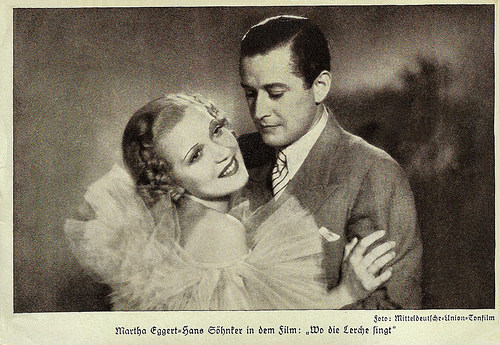
Martha Eggerth and Hans Söhnker in the 1936 sound version of Wo die Lerche singt. German card. Photo: Mitteldeutsche Union Tonfilm. Publicity still for Wo die Lerche singt/Where the Lark Sings (Karel Lamac, 1936).
Sources: Wikipedia (German and English) and IMDb.

German postcard by B.K.W.I., no. 100. Photo: Delta-Film. Publicity still for Wo die Lerche singt/Where the Lark Sings (Hubert Marischka, 1918). From left to right: Louise Kartousch, director/actor Hubert Marischka, composer Franz Lehár and Ernst Tautenhayn.

German postcard by B.K.W.I., no. 103. Photo: Delta-Film. Publicity still for Wo die Lerche singt/Where the Lark Sings (Hubert Marischka, 1918) with Ernst Tautenhayn.

German postcard by B.K.W.I., no. 107. Photo: Delta-Film. Publicity still for Wo die Lerche singt/Where the Lark Sings (Hubert Marischka, 1918) with Ernst Tautenhayn, Louise Kartousch and Mariette Weber.
A country girl in the big city
The libretto of the operetta Wo die Lerche singt by A. M. Willner and Heinz Reichert was inspired by the stage play Dorf und Stadt (Village and City) by Charlotte Birch-Pfeiffer.
The operetta premiered at the Royal Opera in Budapest on 1 January 1918. It was one of Franz Lehár's most successful wartime operettas.
Margit, a young Hungarian country girl (in the film played by Louise Kartousch) travels to a big city where she is seduced and then abandoned by an artist (Hubert Marischka).
Eventually she returns home to the countryside "where the larks sing" and is reconciled with her peasant fiance Pista (Otto Langer). Ernst Tautenhayn played Margit's uncle, the old farmer Törö Pá.
In 1936 the operetta was again adapted into an Operetta film, Wo die Lerche singt/Where the Lark Sings (Carl Lamac, 1936) starring Márta Eggerth . It was a co-production between Hungary, Germany and Switzerland.

German postcard by B.K.W.I., no. 108. Photo: Delta-Film. Publicity still for Wo die Lerche singt/Where the Lark Sings (Hubert Marischka, 1918) with Louise Kartousch and Ernst Tautenhayn.

German postcard by B.K.W.I., no. 109 Photo: Delta-Film. Publicity still for Wo die Lerche singt/Where the Lark Sings (Hubert Marischka, 1918) with Louise Kartousch.

German postcard by B.K.W.I., no. 110. Photo: Delta-Film. Publicity still for Wo die Lerche singt/Where the Lark Sings (Hubert Marischka, 1918) with Ernst Tautenhayn, Louise Kartousch and Otto Langer.

German postcard by B.K.W.L. Photo: Ludwig Gutmann, 1918. Publicity still for Wo die Lerche singt/Where the Lark Sings (Hubert Marischka, 1918). Caption: "Wo ist denn der Mann mit der schönen Frau?" (Where is the man with the beautiful woman?)

Martha Eggerth and Hans Söhnker in the 1936 sound version of Wo die Lerche singt. German card. Photo: Mitteldeutsche Union Tonfilm. Publicity still for Wo die Lerche singt/Where the Lark Sings (Karel Lamac, 1936).
Sources: Wikipedia (German and English) and IMDb.
Published on May 23, 2018 22:00
Paul van Yperen's Blog
- Paul van Yperen's profile
- 13 followers
Paul van Yperen isn't a Goodreads Author
(yet),
but they
do have a blog,
so here are some recent posts imported from
their feed.



